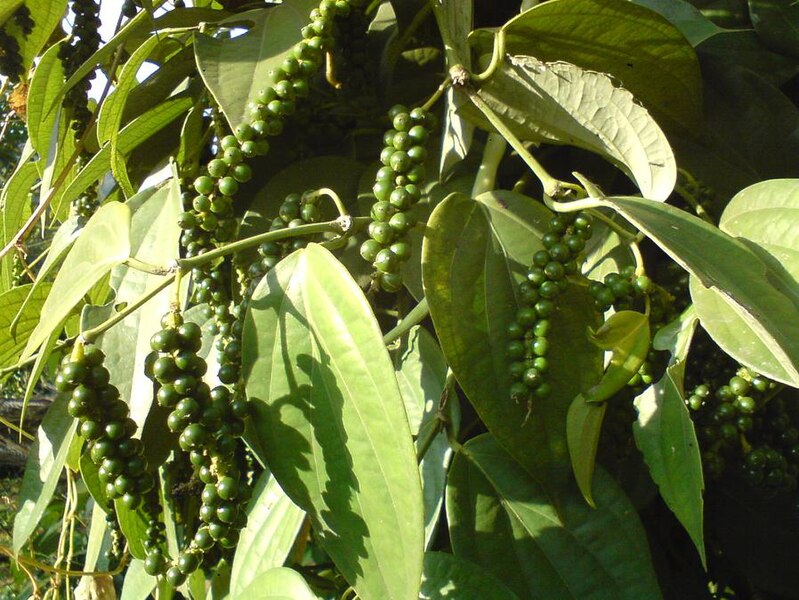New Account | Seed Mix |
Gift Certificates |AAS Winners |
Gardening Products
SEEDS: Unusual | Annuals | Perennials | Vegetables | Herbs | Trees
Plants for Warm Tropical Greenhouses
We recommend the plants below for tropical climates and heated greenhouses. These plants should not be grown in areas where the minimum temperature will reach 65 degrees or lower.
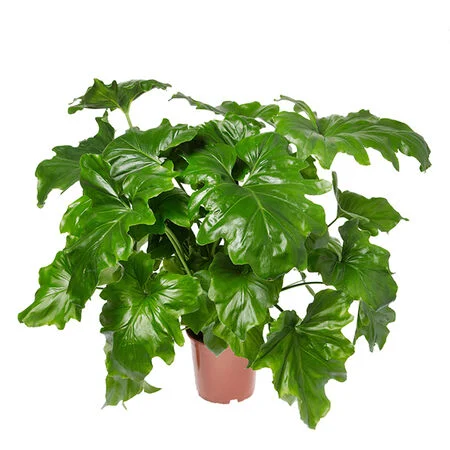
FB139 Selloum Philodendron
This has magnificent foliage with deeply lobed leaves up to 20 inches long and 28 inches
wide. Does well in partial shade and is a good container plant. Eventually forms
palm-like trunk.

W254 Drunken Parrot Tree ( Schotia brachypetala )
The name Drunken Parrot Tree comes from the fact that individual flowers contain so much nectar that it has a tendency to ferment before the birds can eat it all, resulting in a mild narcotic effect on the birds.
These tropical trees will start blooming when they are still quite young. The abundance of rich deep red flowers are produced straight after the new leaves during September and October, but exact flowering times will vary from tree to tree. This irregularity in blooming times is of value to the nectar feeding birds, and ensures a longer feeding season. The flowers produce such copious amounts of nectar that it literally 'weeps' from the flowers.
This is an exceptional ornamental tree for gardens and parks and looks wonderful as part of a larger landscape, or planted singly as a specimen tree. Do not plant it near paved areas or car parks etc, where the dripping nectar could become a problem. When in bloom it will attract a wide variety of birds, animals and insects. The nectar will attract nectar-feeding birds like sunbirds, the nectar will also attract many insects, and therefore insect-eating birds.
Easy to grow in warm frost-free areas, where it remains evergreen and grows surprisingly fast. In colder, dry, inland regions it is slower-growing and deciduous, losing its leaves for a short period in winter or spring. It is semi-hardy to moderate frost if it is planted in a protected part of the garden and young trees are covered in winter, until they are more established. An established tree can withstand minimum winter temperatures of about 24 degrees. It is remarkably hardy in dry regions with poor soil, but for best results in the garden, plant in deep very well-drained soil, to which generous quantities of compost has been added and a dressing of bonemeal. A general purpose granular fertiliser can be used during the growing season. It loves in full sun and will respond well to judicious watering in the garden, especially when young, and during prolonged dry periods.
These tropical trees will start blooming when they are still quite young. The abundance of rich deep red flowers are produced straight after the new leaves during September and October, but exact flowering times will vary from tree to tree. This irregularity in blooming times is of value to the nectar feeding birds, and ensures a longer feeding season. The flowers produce such copious amounts of nectar that it literally 'weeps' from the flowers.
This is an exceptional ornamental tree for gardens and parks and looks wonderful as part of a larger landscape, or planted singly as a specimen tree. Do not plant it near paved areas or car parks etc, where the dripping nectar could become a problem. When in bloom it will attract a wide variety of birds, animals and insects. The nectar will attract nectar-feeding birds like sunbirds, the nectar will also attract many insects, and therefore insect-eating birds.
Easy to grow in warm frost-free areas, where it remains evergreen and grows surprisingly fast. In colder, dry, inland regions it is slower-growing and deciduous, losing its leaves for a short period in winter or spring. It is semi-hardy to moderate frost if it is planted in a protected part of the garden and young trees are covered in winter, until they are more established. An established tree can withstand minimum winter temperatures of about 24 degrees. It is remarkably hardy in dry regions with poor soil, but for best results in the garden, plant in deep very well-drained soil, to which generous quantities of compost has been added and a dressing of bonemeal. A general purpose granular fertiliser can be used during the growing season. It loves in full sun and will respond well to judicious watering in the garden, especially when young, and during prolonged dry periods.

JB111 Tamarind ( Tamarindus indica )
The tamarind is a large tropical tree with a short massive
trunk, ferny pinnate leaves, small yellow flowers and fat
reddish brown pods. The tree can get 90 ft (27.4 m) tall but is
usually less than 50 ft (15.2 ft). It has a short, stocky
trunk, drooping branches and a domed umbrella shaped crown
about as wide as the tree's height. The leaves are about 10 in
(25.4 cm) long with 10-18 pairs of 1 in (2.5 cm) oblong
leaflets. Tamarind drops its leaves in pronounced dry seasons;
in climates without a dry season it stays evergreen. The
flowers are about 1 in (2.5 cm) across, pale yellow with purple
or red veins. They have five unequal lobes and borne in small
drooping clusters. The velvety cinnamon brown pods are 2-6 in
(5.1-15.2 cm) long, sausage shaped and constricted between the
seeds. The pulp that surrounds the 8-10 seeds is both sweet and
extremely sour.
Tamarinds are grown as ornamental shade and street trees, and for the edible pods. The pods are fed to livestock, and the pulp within the pods is used to make beverages, curries, chutneys and sauces. Tamarind pulp is made into a soft drink known as refresco de tamarindo in Latin America, and tamarinade in Jamaica. It's also the basis of a popular drink in the Middle East. Tamarind is used extensively in Indian and Southeast Asian cuisine, and is an important ingredient in Worcestershire sauce. The juice is used to pickle fish in India. Several medicinal uses of tamarind are reported in Grieve's A Modern Herbal. The fruit is said to improve digestion, relieve gas, soothe sore throats, and act as a mild laxative.
The tamarind tree is a beautiful, fine textured tree and it makes an excellent shade tree in large landscapes. It often is planted in public parks and as an avenue tree in tropical cities. Best for zones 10 and up.
Tamarinds are grown as ornamental shade and street trees, and for the edible pods. The pods are fed to livestock, and the pulp within the pods is used to make beverages, curries, chutneys and sauces. Tamarind pulp is made into a soft drink known as refresco de tamarindo in Latin America, and tamarinade in Jamaica. It's also the basis of a popular drink in the Middle East. Tamarind is used extensively in Indian and Southeast Asian cuisine, and is an important ingredient in Worcestershire sauce. The juice is used to pickle fish in India. Several medicinal uses of tamarind are reported in Grieve's A Modern Herbal. The fruit is said to improve digestion, relieve gas, soothe sore throats, and act as a mild laxative.
The tamarind tree is a beautiful, fine textured tree and it makes an excellent shade tree in large landscapes. It often is planted in public parks and as an avenue tree in tropical cities. Best for zones 10 and up.

Rison Thumboor from Thrissur, India, CC BY 2.0, via Wikimedia Commons
TRZ154 Appleblossom Cassia ( Cassia nodosa )
Spectacular medium size fast growing tree with a fine spreading crown. Masses of bubbly fragrant pink appleblossom flowers appear in spring-summer held in cascading clusters along downy branches.
Lovely, tropical, rich green, pinnate foliage. Briefly deciduous during dry season. The flowers range in colour from pale pink to crimson with yellow coloured stamens and are found in open clusters. The ground under the tree is covered with a beautiful carpet of pink towards the end of the flowering season.
For zones 9A through 11.
Lovely, tropical, rich green, pinnate foliage. Briefly deciduous during dry season. The flowers range in colour from pale pink to crimson with yellow coloured stamens and are found in open clusters. The ground under the tree is covered with a beautiful carpet of pink towards the end of the flowering season.
For zones 9A through 11.

Image: By Wouter Hagens [Public domain], from Wikimedia Commons
LET910 African Tulip Tree ( Spathodea campanulata )
This is a large upright tree with glossy deep green pinnate leaves and glorious orange scarlet flowers. It may grow to 80 ft on an ideal site, but most specimens are much smaller. The tree has a stout, tapering, somewhat buttressed trunk covered in warty light gray bark. The lateral branches are short and thick. The 1-2 feet long opposite leaves, which emerge a bronzy color, are massed at the ends of the branches. They are composed of 5-19 deeply veined oval leaflets.
The horn shaped velvety olive buds appear in upturned whorls at the branch tips. A few at a time, the buds of the lowest tier bend outward and open into big crinkled red orange tuliplike bells with red streaked gold throats, frilly yellow edges, and four brown-anthered stamens in the center. They are followed by 5-10 inch green brown fingerlike pods pointing upwards and outwards above the foliage. Each of these pods contains about 500 tissue papery seeds. The tree flowers in spurts all through the growing season, but peak bloom is usually in the spring.
This species loves rich soil, but puts up with just about anything with a little fertility to it, including limerock. It is not a beachfront plant, but will survive a bit of salinity. African tuliptrees need serious pruning after every freeze or windstorm. Gardeners in marginal regions should plan on growing this as a large ephemeral shrub and plant it in a sheltered place where it can be reached by ladders or bucket trucks for regular pruning and removal of dead branches. Light: African tuliptree will survive in shade, but demands full sun for fast growth and best flowering.
Moisture: These trees grow best with plenty of moisture, but will shed their leaves and endure drought.
Hardiness: USDA Zones 10-11. African tuliptrees drop their leaves when chilled and freeze easily, but they come back from the roots vigorously and often bloom the next season. Top growth will be killed at 28-30 degrees but the roots may survive down to 22 degrees or below.
The smooth gray bark provides a beautiful background for the brilliant red flowers of the African tuliptree. Usage African tuliptrees are grown for shade, color and tropical effects. The wood is difficult to burn, so the tree is also valuable for fire resistant landscaping. The wood has been used for blacksmith's bellows and the like. The buds contain a liquid that will squirt out if they are squeezed or pierced and children enjoy using these as water pistols. They also enjoy playing with the boatlike open seed pods. In Africa and Haiti, the flowers are thought to have magical properties and the wood is used for witch doctors' wands.
Features This is one of the world's most spectacular flowering trees. It is also very fast growing. Young trees may put on 6 feet in height and 2 inches in diameter per year and often begin blooming when they are only a few years old.
The horn shaped velvety olive buds appear in upturned whorls at the branch tips. A few at a time, the buds of the lowest tier bend outward and open into big crinkled red orange tuliplike bells with red streaked gold throats, frilly yellow edges, and four brown-anthered stamens in the center. They are followed by 5-10 inch green brown fingerlike pods pointing upwards and outwards above the foliage. Each of these pods contains about 500 tissue papery seeds. The tree flowers in spurts all through the growing season, but peak bloom is usually in the spring.
This species loves rich soil, but puts up with just about anything with a little fertility to it, including limerock. It is not a beachfront plant, but will survive a bit of salinity. African tuliptrees need serious pruning after every freeze or windstorm. Gardeners in marginal regions should plan on growing this as a large ephemeral shrub and plant it in a sheltered place where it can be reached by ladders or bucket trucks for regular pruning and removal of dead branches. Light: African tuliptree will survive in shade, but demands full sun for fast growth and best flowering.
Moisture: These trees grow best with plenty of moisture, but will shed their leaves and endure drought.
Hardiness: USDA Zones 10-11. African tuliptrees drop their leaves when chilled and freeze easily, but they come back from the roots vigorously and often bloom the next season. Top growth will be killed at 28-30 degrees but the roots may survive down to 22 degrees or below.
The smooth gray bark provides a beautiful background for the brilliant red flowers of the African tuliptree. Usage African tuliptrees are grown for shade, color and tropical effects. The wood is difficult to burn, so the tree is also valuable for fire resistant landscaping. The wood has been used for blacksmith's bellows and the like. The buds contain a liquid that will squirt out if they are squeezed or pierced and children enjoy using these as water pistols. They also enjoy playing with the boatlike open seed pods. In Africa and Haiti, the flowers are thought to have magical properties and the wood is used for witch doctors' wands.
Features This is one of the world's most spectacular flowering trees. It is also very fast growing. Young trees may put on 6 feet in height and 2 inches in diameter per year and often begin blooming when they are only a few years old.

Image:Lalithamba from India
BM20 Glory Lily (
Gloriosa rothschildiana )
Gloriosa superba 'Rothschildiana,' also known as the flame lily or glory lily, is a tropical climbing vine with exotic, red and yellow flowers, native to Africa and Asia, and is a deciduous perennial that thrives in zones 8-12.
The name means "full of glory", appropriate for such showy exotics. These tender perennials form sizeable clumps and will grow 4 to 6 feet in a season. Vines are light weight, so do not require stout supports. Easy to grow and excellent for summer decks, and inside in sunrooms and greenhouses where there is sufficient room for vining plants. In cooler zones than 8b, lift in fall and store indoors or grow as houseplant, height: 4-6 feet,vining, color: flashy yellow and ruby flowers with wavy, swept-back petals.
The name means "full of glory", appropriate for such showy exotics. These tender perennials form sizeable clumps and will grow 4 to 6 feet in a season. Vines are light weight, so do not require stout supports. Easy to grow and excellent for summer decks, and inside in sunrooms and greenhouses where there is sufficient room for vining plants. In cooler zones than 8b, lift in fall and store indoors or grow as houseplant, height: 4-6 feet,vining, color: flashy yellow and ruby flowers with wavy, swept-back petals.

3524 Black Bat Flower ( Tacca chantrieri )
A most unusual plant introduced from parts of Malaysia, India, and East Asia, the Bat Plant will make you look twice. The main attraction of the plant is the strange, unique, purple-black flowers.
The flowers superficially resemble a bat in flight with long whiskers, and can grow up to 10 inches long. Taccas can be picky about their environmental conditions; however they grow fast and flower a lot when the conditions are just right. The Bat Plant should be planted in partial shade and in a humid and warm environment.
Soil should remain consistently moist, not allowing the plant to dry out between waterings. In winter months, when temperatures drop to 40F or lower, the Bat Plant should be moved indoors, or into a greenhouse to protect it from cold damage.
Makes a great container plant and is a real conversation piece.
The flowers superficially resemble a bat in flight with long whiskers, and can grow up to 10 inches long. Taccas can be picky about their environmental conditions; however they grow fast and flower a lot when the conditions are just right. The Bat Plant should be planted in partial shade and in a humid and warm environment.
Soil should remain consistently moist, not allowing the plant to dry out between waterings. In winter months, when temperatures drop to 40F or lower, the Bat Plant should be moved indoors, or into a greenhouse to protect it from cold damage.
Makes a great container plant and is a real conversation piece.
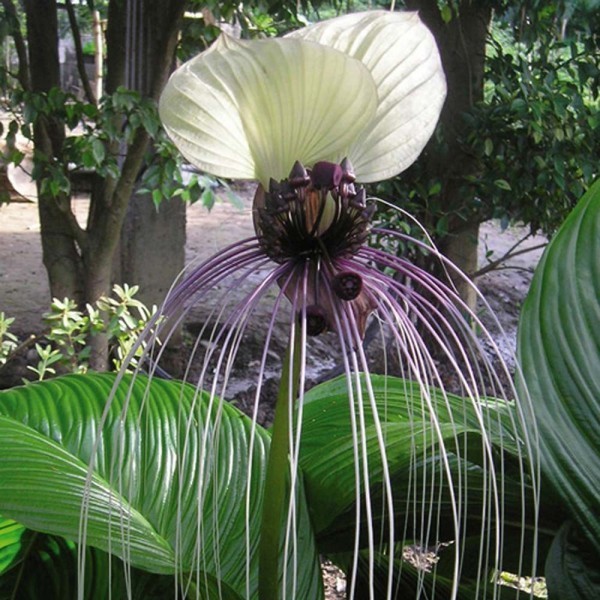
3525 White Bat Flower ( Tacca nivea )
These can be grown as a fasinating houseplant, our outside in the shade in warm climates. Brilliant white flowers to 12" width stand upright with the petals spread to the extent that they appear as a white dove - or as a bat-like form. The throat shows the coloration of faint purple- brown, and from this region protrude 10-20 prominent dark purple bracts. Flowing from this area are up to 30 thin white tentacles "whiskers". An irresistible plant for many. In the wild they grow in tropical and subtropical Asia, and in cooler climates they grow best in a shady area in a hot, humid greenhouse. Zone 10 or higher outdoors, or grow indoors in cooler climates.
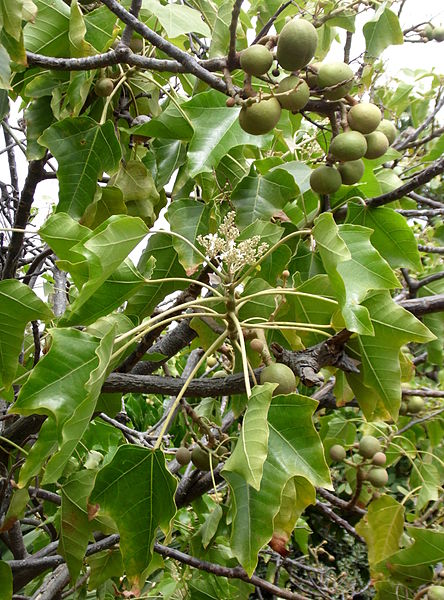
Image: By Krzysztof Ziarnek, Kenraiz [CC BY-SA 3.0], from Wikimedia Commons
RMC003 Candle Nut Tree ( Aleurites moluccana )
The Candlenut, is a flowering tree in the spurge family, Euphorbiaceae, also known as Candleberry, Indian walnut, Kemiri, Varnish tree, Nuez de la India, Buah keras or Kukui nut tree.
A medium or large sized, spreading, tropical tree up to 50-80ft tall.
Cooked nuts are generally edible, although some strains contain high amounts of cyanide. Usually the nut is pressed for its oil, which is used for a variety of industrial purposes like soap making, varnishes, and fuel.
The oil is sometimes used medicinally similar to castor oil, as well as a laxative. In Southeast Asia, the oil is sometimes applied topically to treat headaches, fevers and swollen joints.
In Ancient Hawaii, kukui nuts were burned to provide light. The nuts were strung in a row on a palm leaf midrib, lit one end, and burned one by one every 15 minutes or so. This led to their use as a measure of time. One could instruct someone to return home before the second nut burned out. Hawaiians also extracted the oil from the nut and burned it in a stone oil lamp called a kukui hele po (light, darkness goes) with a wick made of kapa cloth.
Hawaiians also had many other uses for the tree, including: leis from the shells, leaves and flowers; ink for tattoos from charred nuts; a varnish with the oil; and fishermen would chew the nuts and spit them on the water to break the surface tension and remove reflections, giving them greater underwater visibility. A red-brown dye made from the inner bark was used on kapa and aho (Touchardia latifolia cordage). A coating of kukui oil helped preserve fishing nets. The trunk was sometimes used to make smaller canoes used for fishing. Kukui was named the state tree of Hawaii on 1 May 1959 due to its multitude of uses.
In Tonga, even today, ripe nuts, named tuitui are pounded into a paste, tukilamulamu, and used as soap or shampoo. As recently as 1993, candlenuts were chewed into sweet-scented emollient utilized during a traditional funerary ritual in the outlying islands of the Kingdom of Tonga. Their scent was also used for making various sweet smelling oils for the skin.
Dead wood of candlenut is eaten by a larva of a coleoptera called Agrionome fairmairei. This larva is eaten by some people.
Modern cultivation is mostly for the oil. In plantations, each tree will produce 30-80 kg (66-180 lb) of nuts, and the nuts yield 15 to 20% of their weight in oil. Most of the oil is used locally rather than figuring in international trade.
They grow very well in tropical climates with ample rainfall, but also adapt to dry climates. Candlenut's need little if any care after they are established.
Hardiness: Candlenut trees are somewhat hardy and will survive temperatures to 25-28F.
The oil is sometimes used medicinally similar to castor oil, as well as a laxative. In Southeast Asia, the oil is sometimes applied topically to treat headaches, fevers and swollen joints.
In Ancient Hawaii, kukui nuts were burned to provide light. The nuts were strung in a row on a palm leaf midrib, lit one end, and burned one by one every 15 minutes or so. This led to their use as a measure of time. One could instruct someone to return home before the second nut burned out. Hawaiians also extracted the oil from the nut and burned it in a stone oil lamp called a kukui hele po (light, darkness goes) with a wick made of kapa cloth.
Hawaiians also had many other uses for the tree, including: leis from the shells, leaves and flowers; ink for tattoos from charred nuts; a varnish with the oil; and fishermen would chew the nuts and spit them on the water to break the surface tension and remove reflections, giving them greater underwater visibility. A red-brown dye made from the inner bark was used on kapa and aho (Touchardia latifolia cordage). A coating of kukui oil helped preserve fishing nets. The trunk was sometimes used to make smaller canoes used for fishing. Kukui was named the state tree of Hawaii on 1 May 1959 due to its multitude of uses.
In Tonga, even today, ripe nuts, named tuitui are pounded into a paste, tukilamulamu, and used as soap or shampoo. As recently as 1993, candlenuts were chewed into sweet-scented emollient utilized during a traditional funerary ritual in the outlying islands of the Kingdom of Tonga. Their scent was also used for making various sweet smelling oils for the skin.
Dead wood of candlenut is eaten by a larva of a coleoptera called Agrionome fairmairei. This larva is eaten by some people.
Modern cultivation is mostly for the oil. In plantations, each tree will produce 30-80 kg (66-180 lb) of nuts, and the nuts yield 15 to 20% of their weight in oil. Most of the oil is used locally rather than figuring in international trade.
They grow very well in tropical climates with ample rainfall, but also adapt to dry climates. Candlenut's need little if any care after they are established.
Hardiness: Candlenut trees are somewhat hardy and will survive temperatures to 25-28F.

Image: By Varun Pabrai [CC BY-SA 4.0], from Wikimedia Commons
TRZ177 Butterfly Tree ( Bauhinia purpurea )
Bauhinia purpurea is a species of flowering plant in the family
Fabaceae, native to South China (which includes Hong Kong) and
southeastern Asia. In the United States of America, the tree
grows in Hawaii, coastal California, southern Texas, and
southwest Florida. Common names include Hong Kong Orchid Tree,
Purple camel's foot, and Hawaiian orchid tree.
It is a small to medium-sized deciduous tree growing to 17 m tall. The leaves are 10-20 cm long and broad, rounded, and bilobed at the base and apex. The flowers are conspicuous, pink and fragrant, with five petals. For zones 9-10.
It is a small to medium-sized deciduous tree growing to 17 m tall. The leaves are 10-20 cm long and broad, rounded, and bilobed at the base and apex. The flowers are conspicuous, pink and fragrant, with five petals. For zones 9-10.
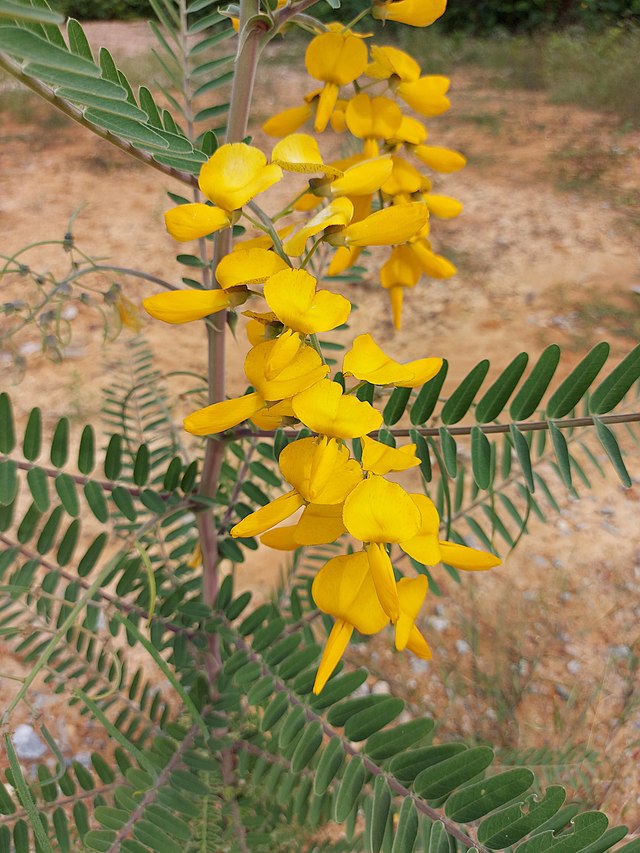
Image: 白布飘扬, CC BY-SA 4.0, via Wikimedia Commons
LET369 Fragrant Dhaincha ( Sesbania javanica )
A short lived perennial or annual shrub growing 10-12 feet tall with a wispy habit, finely pinnate leaves and masses of fragrant yellow flowers. Makes a wonderful tub plant. Sesbania javanica is widespread in tropical Asia and widely cultivated as an for its edible flowers and young shoots that are popular as a vegetable. The flowers also serve as a yellow food coloring.
The plant is harvested from the wild for local use as a food and medicine. The flowers are commonly harvested and sold as a food crop in local markets in Thailand. It is cultivated as a green manure and shade plant, and is also often grown as a hedge and an ornamental.
Bring in a vase full of flowers to for their delightful fragrance. Grow as a tub plant in cooler zones or as an annual. If growing as an annual, start seeds inside in winter for flowers the following season. Zone 9-10 outside.
The plant is harvested from the wild for local use as a food and medicine. The flowers are commonly harvested and sold as a food crop in local markets in Thailand. It is cultivated as a green manure and shade plant, and is also often grown as a hedge and an ornamental.
Bring in a vase full of flowers to for their delightful fragrance. Grow as a tub plant in cooler zones or as an annual. If growing as an annual, start seeds inside in winter for flowers the following season. Zone 9-10 outside.
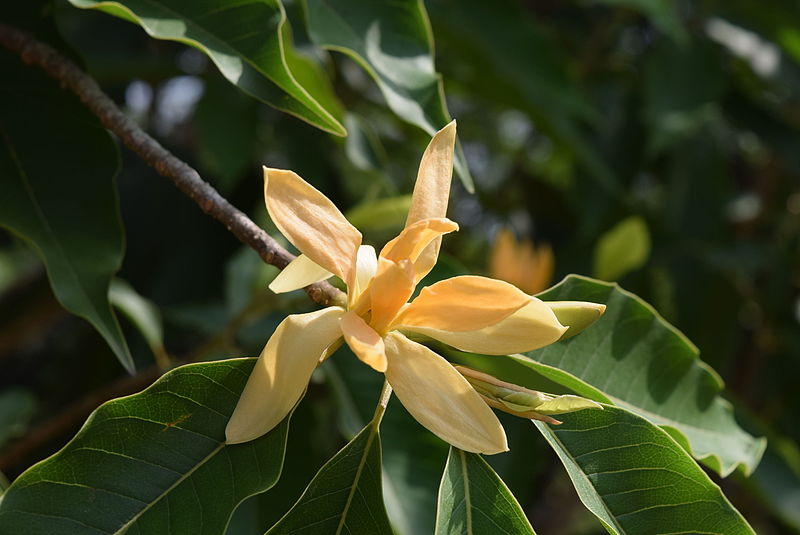
Image: Varun Pabrai, CC BY-SA 4.0, via Wikimedia Commons
IP150 Joy Perfume Tree ( Michelia champaca )
Syn. Magnolia champaca. Excellent houseplant for colder zones or garden plant for warmer zones ( 10 and above ). The fragrance of the flower is simply amazing.
Also known as Champa, Yellow Champa, Golden Campa or Fragrant Champa is highly revered by the followers of Hinduism and Buddhism. They use Michelia flowers during religious ceremonies. Tibetans believe that the Buddha of the next era will find enlightenment under the flower canopy of the champaca tree.
Michelia has several ornamental, commercial and medicinal uses too. For gardeners, it is an excellent choice as a houseplant or as companion plant in landscapes. Commercially, the timber of Michelia is used for almost anything from cabinet-making to firewood and flowers are grown to sell at cut flower shops. The extract from the flowers of Michelia Alba is used in preparation of the famous 'Joy' perfume. Medicinally, the tree has wide applications; the bark is used to prepare tonic, the oil extracted from flowers is used to cure toughs and rheumatism, and for relieving eye troubles and gout.
Michelias are easy to grow and maintain. They love a lot of light and warmth but filtered sunlight. The best location for Michelia is the place where it receives direct and ample sunlight in early morning but partial light for the rest of the day. Suitable for containers, Michelias has shallow and brittle root system. It likes moderate watering in acidic and well-drained soil. As a general rule, water lavishly when the plant is young to allow it to develop good root system. Water mature trees moderately and feed with a general purpose fertilizer during spring. Prune in winter when plant goes dormant.
Outdoors in zone 10 or higher, Michelia can gain a height of 75 feet or more in suitable conditions. The tree bears large leaves that resemble the leaves of Mango tree. The tree booms from May to October and produces abundance of star-shaped flowers that fill the entire surrounding with mesmerizing scent. Flowers are usually golden-yellow, golden-orange and creamy-white.
Also known as Champa, Yellow Champa, Golden Campa or Fragrant Champa is highly revered by the followers of Hinduism and Buddhism. They use Michelia flowers during religious ceremonies. Tibetans believe that the Buddha of the next era will find enlightenment under the flower canopy of the champaca tree.
Michelia has several ornamental, commercial and medicinal uses too. For gardeners, it is an excellent choice as a houseplant or as companion plant in landscapes. Commercially, the timber of Michelia is used for almost anything from cabinet-making to firewood and flowers are grown to sell at cut flower shops. The extract from the flowers of Michelia Alba is used in preparation of the famous 'Joy' perfume. Medicinally, the tree has wide applications; the bark is used to prepare tonic, the oil extracted from flowers is used to cure toughs and rheumatism, and for relieving eye troubles and gout.
Michelias are easy to grow and maintain. They love a lot of light and warmth but filtered sunlight. The best location for Michelia is the place where it receives direct and ample sunlight in early morning but partial light for the rest of the day. Suitable for containers, Michelias has shallow and brittle root system. It likes moderate watering in acidic and well-drained soil. As a general rule, water lavishly when the plant is young to allow it to develop good root system. Water mature trees moderately and feed with a general purpose fertilizer during spring. Prune in winter when plant goes dormant.
Outdoors in zone 10 or higher, Michelia can gain a height of 75 feet or more in suitable conditions. The tree bears large leaves that resemble the leaves of Mango tree. The tree booms from May to October and produces abundance of star-shaped flowers that fill the entire surrounding with mesmerizing scent. Flowers are usually golden-yellow, golden-orange and creamy-white.
Z2101 Black Pepper Vine (Piper Nigrum)
A vigorous tropical vine with glossy green leaves grown for commercial production of pepper. Can be grown on trellises outside or used as a houseplant for most regions of US.
Black pepper plants make an attractive addition to your house or garden. Once grown, they develop dainty white flowers before producing fruit. The fruits will appear as clusters of round berries in a chain formation.
Conditions for growing black pepper plants require high temps, heavy and frequent rainfall, and well-draining soil, all of which are met in the countries of India, Indonesia, and Brazil where most of the commercial peppercorns are grown. Most growers in the USA grow these in containers inside the home or greenhouse. These warm loving plants will stop growing when temps drop below 65 degrees F. (18 C.) and do not tolerate frost; as such, they make great container plants. Situate in full sun with 50 percent or greater humidity, or inside the house or greenhouse if your region does not fit these criteria.
In its native habit of southern India, Black Pepper is an understory plant that climbs up trees and grows in dappled light. When grown as a houseplant, it needs moderate light in an east or west window and it should be placed directly on the windowsill or close to your light source if grown in a light garden. It does benefit from some direct sunlight but not hot noonday sun. Like other tropical plants, Black Pepper can be grown outside during the summer months and brought inside for the winter.
The flowers start growing at the leaf nodes of new growth. The small white flowers form pendulous spikes and then small, round, green peppercorns form in chains, which in time ripen to red. Growth slows down in the winter, yet it will fruit and flower year-round. The pepper plant can produce an abundance of peppercorns in a pot as small as 8-inches.
To fertilize, use a soluble or liquid fertilizer applied every two weeks when you water. Don’t over fertilize your black pepper plant, as a rule of thumb, the less light, the less often you fertilize, so outside in summer means more, inside in winter less.
Black pepper plants make an attractive addition to your house or garden. Once grown, they develop dainty white flowers before producing fruit. The fruits will appear as clusters of round berries in a chain formation.
Conditions for growing black pepper plants require high temps, heavy and frequent rainfall, and well-draining soil, all of which are met in the countries of India, Indonesia, and Brazil where most of the commercial peppercorns are grown. Most growers in the USA grow these in containers inside the home or greenhouse. These warm loving plants will stop growing when temps drop below 65 degrees F. (18 C.) and do not tolerate frost; as such, they make great container plants. Situate in full sun with 50 percent or greater humidity, or inside the house or greenhouse if your region does not fit these criteria.
In its native habit of southern India, Black Pepper is an understory plant that climbs up trees and grows in dappled light. When grown as a houseplant, it needs moderate light in an east or west window and it should be placed directly on the windowsill or close to your light source if grown in a light garden. It does benefit from some direct sunlight but not hot noonday sun. Like other tropical plants, Black Pepper can be grown outside during the summer months and brought inside for the winter.
The flowers start growing at the leaf nodes of new growth. The small white flowers form pendulous spikes and then small, round, green peppercorns form in chains, which in time ripen to red. Growth slows down in the winter, yet it will fruit and flower year-round. The pepper plant can produce an abundance of peppercorns in a pot as small as 8-inches.
To fertilize, use a soluble or liquid fertilizer applied every two weeks when you water. Don’t over fertilize your black pepper plant, as a rule of thumb, the less light, the less often you fertilize, so outside in summer means more, inside in winter less.
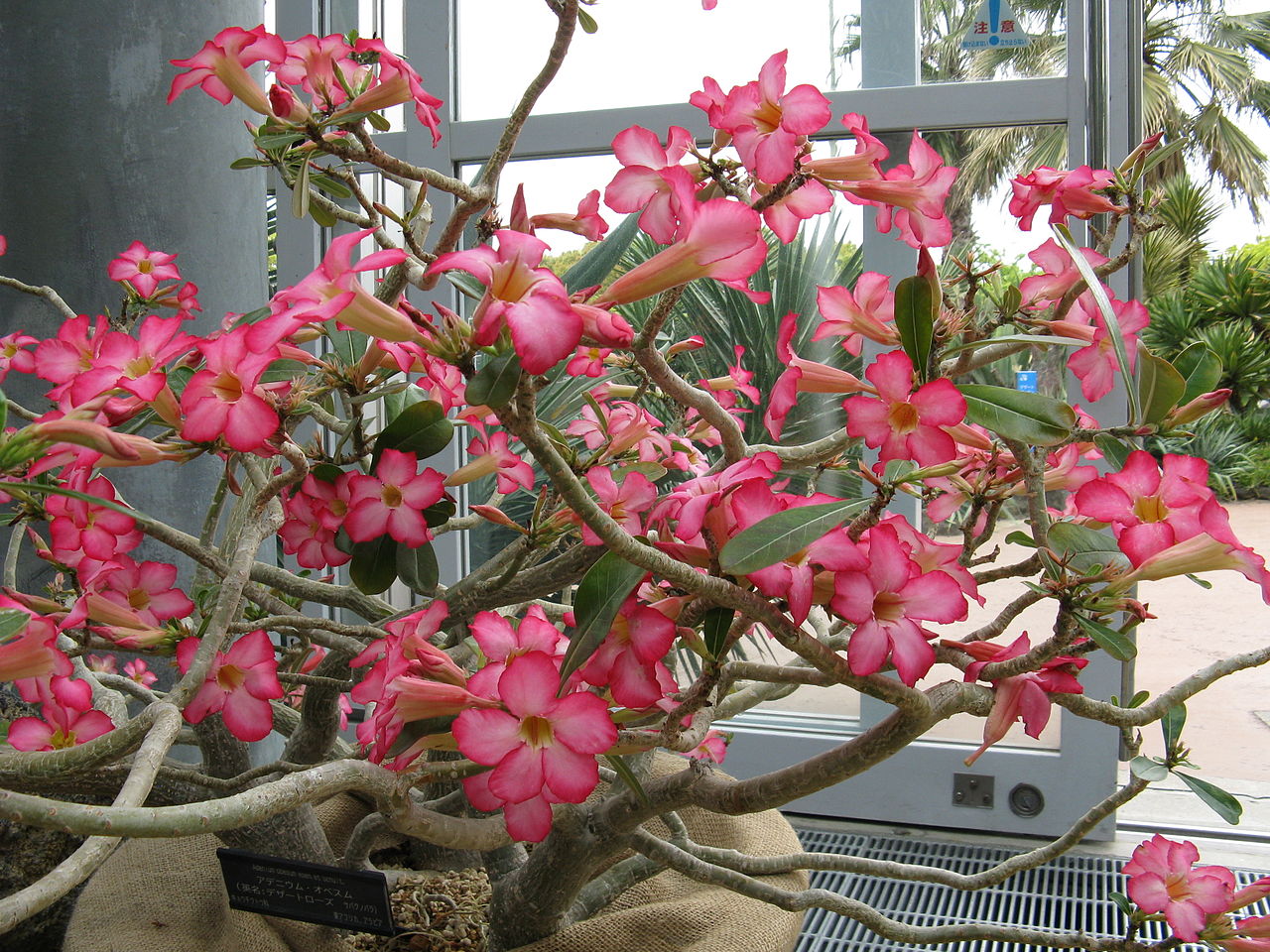
3557 Desert Rose ( Adenium obesum )
If you would like to grow a gorgeous houseplant requiring very little care, you cannot go wrong with the common Desert Rose plant.
This carefree succulent boasts an unusual trunk (caudex) shape coupled with bunches of beautiful, colorful, trumpet-shaped flowers in an abundance of carmine-rose colors.
The plant makes an excellent warm-weather addition to your patio, deck or landscape, and it also does very well as a bonsai or houseplant.
Winter hardy to Zone 11. In colder zones, plants should be grown in containers and overwintered indoors. In containers, desert rose is best grown in a loose, sandy or gravelly, well-drained soil mix in full sun. Plants have excellent heat tolerance. Apply regular moisture during periods of growth, but allow soils to dry between waterings. Regular applications of fertilizer in spring will help promote flowering. Plants can be left outdoors in sunny locations during the summer. As soon as temperatures begin to dip below 55 degrees F. in autumn, bring containers indoors to sunny but cool locations with reduced watering. Plants usually lose their leaves in winter and go into a dormancy-like period. For container plants, the best caudex usually develops from seed-grown plants.
This carefree succulent boasts an unusual trunk (caudex) shape coupled with bunches of beautiful, colorful, trumpet-shaped flowers in an abundance of carmine-rose colors.
The plant makes an excellent warm-weather addition to your patio, deck or landscape, and it also does very well as a bonsai or houseplant.
Winter hardy to Zone 11. In colder zones, plants should be grown in containers and overwintered indoors. In containers, desert rose is best grown in a loose, sandy or gravelly, well-drained soil mix in full sun. Plants have excellent heat tolerance. Apply regular moisture during periods of growth, but allow soils to dry between waterings. Regular applications of fertilizer in spring will help promote flowering. Plants can be left outdoors in sunny locations during the summer. As soon as temperatures begin to dip below 55 degrees F. in autumn, bring containers indoors to sunny but cool locations with reduced watering. Plants usually lose their leaves in winter and go into a dormancy-like period. For container plants, the best caudex usually develops from seed-grown plants.

Image: By Joan Simon from Barcelona, España (Cananga odorata) [CC BY-SA 2.0], via Wikimedia Commons
IP310 Ylang Ylang Tree ( Cananga odorata )
A fast growing tropical tree. The fragrant flowers will perfume a large area around the plant. The essential oil is used in aromatherapy. The evergreen leaves are smooth and glossy, oval, pointed and with wavy margins. The flower is drooping, long-stalked, with six narrow, greenish-yellow (rarely pink) petals, rather like a sea star in appearance, and yields a highly fragrant essential oil.
It is believed to relieve high blood pressure and normalize sebum secretion for skin problems, and is considered to be an aphrodisiac. The oil from ylang-ylang is widely used in perfumery for oriental- or floral-themed perfumes (such as Chanel No. 5). Ylang-ylang blends well with most floral, fruit and wood scents.
In Indonesia, ylang-ylang flowers are spread on the bed of newlywed couples. In the Philippines, its flowers, together with the flowers of the sampaguita, are strung into a necklace (lei) and worn by women and used to adorn religious images. Will flower in a container. Great tropical flowering tree! Zone 10 and higher outside or grow as a patio plant in cooler zones.
It is believed to relieve high blood pressure and normalize sebum secretion for skin problems, and is considered to be an aphrodisiac. The oil from ylang-ylang is widely used in perfumery for oriental- or floral-themed perfumes (such as Chanel No. 5). Ylang-ylang blends well with most floral, fruit and wood scents.
In Indonesia, ylang-ylang flowers are spread on the bed of newlywed couples. In the Philippines, its flowers, together with the flowers of the sampaguita, are strung into a necklace (lei) and worn by women and used to adorn religious images. Will flower in a container. Great tropical flowering tree! Zone 10 and higher outside or grow as a patio plant in cooler zones.
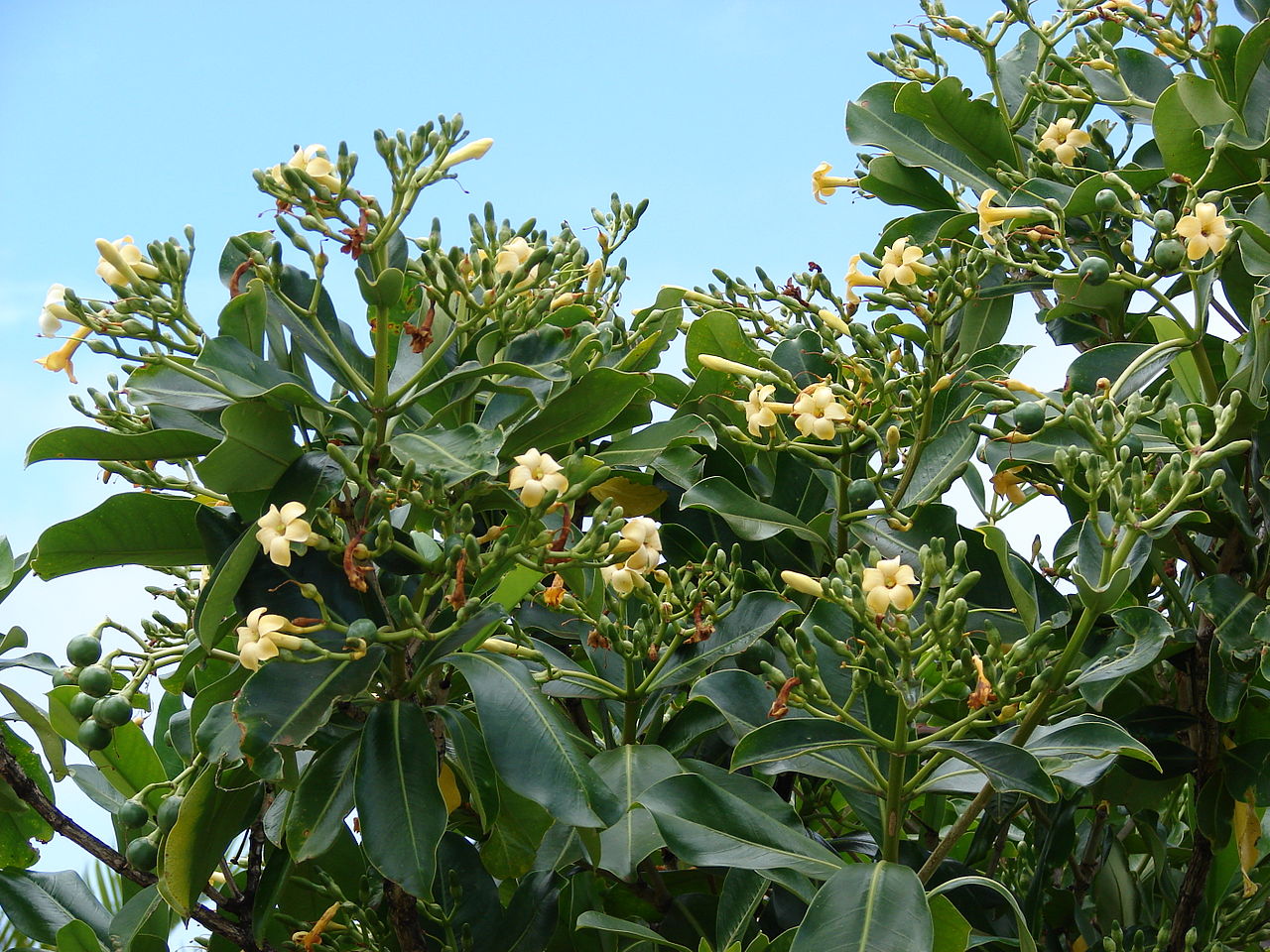
IP295 Perfume Tree ( Fagraea berteriana )
A large tropical plant outside in warm zones, can be container grown inside. Terminal clusters of white flowers that age to orange are laden with a heavy yet pleasing perfumed scent. Fagraeas are often used in leis in Hawaii; the fragrance will hold even after the blooms have dried. Give this slow grower plenty of warmth and direct sunlight and it will be a steady grower and reliable bloomer. Grow in a porous potting mix for its semi-epiphytic nature. In the north, blooms from spring to fall. In the south it is a year-round bloomer.
It is a popular ornamental in tropical Asia as it is adaptable and can be cut into nearly any shape. It is also popular for its very hard, high quality wood.
Fagraea is one of the most fragrant plants to grow in containers. Plants flower intermittently throughout the years with blooms arising on the flush of the new growth. As they are semiepiphytic, they do best in an open well-drained potting mix and be sure there is some dryness to the mix between waterings. They can be grown in sphagnum moss if moisture is checked regularly. Very small seeds.
Zone 10 and higher outside, container grown in cooler zones.
It is a popular ornamental in tropical Asia as it is adaptable and can be cut into nearly any shape. It is also popular for its very hard, high quality wood.
Fagraea is one of the most fragrant plants to grow in containers. Plants flower intermittently throughout the years with blooms arising on the flush of the new growth. As they are semiepiphytic, they do best in an open well-drained potting mix and be sure there is some dryness to the mix between waterings. They can be grown in sphagnum moss if moisture is checked regularly. Very small seeds.
Zone 10 and higher outside, container grown in cooler zones.
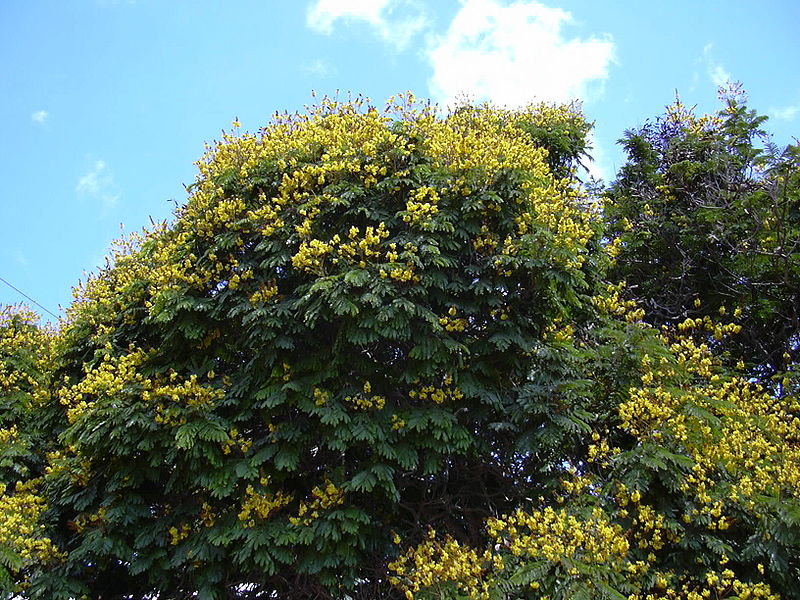
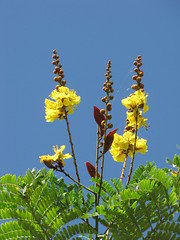
Image: Forest & Kim Starr, CC BY 3.0, via Wikimedia Commons
TRZ136 Copper Pod Tree ( Peltophorum pterocarpum )
This fine tree for warm zones has beauty, fragrance and makes a great shade tree! Also known as Yellow Poinciana. This upright, handsome, spreading, semi-evergreen tree has a rounded canopy and is capable of reaching 50 feet in height with a 30 to 50-foot spread. Form can be quite variable from tree to tree.
With proper training and pruning in the nursery and in the landscape, a more uniform crown will develop. The dark green, delicate, feathery leaflets provide a softening effect for the tree's large size and create a welcoming, dappled shade. From May through September, the entire tree's canopy is smothered with a yellow blanket of flowers, appearing in showy, terminal panicles and exuding a delicious, grape-like perfume. These flower clusters are followed by four-inch-long seed pods which ripen to a brilliant, coppery red.
Medicinal uses: bark for dysentry, tooth powder, eye lotion, embrocation for pains and sores; the bark gives a dye of a yellow color. Can be used as a shade or specimen tree.
USDA hardiness zone 10b. It is a fast-growing tree. Temperatures in the high 20's cause the leaves to drop but these are quickly replaced. Young trees flower in 2-3 years from seed.
With proper training and pruning in the nursery and in the landscape, a more uniform crown will develop. The dark green, delicate, feathery leaflets provide a softening effect for the tree's large size and create a welcoming, dappled shade. From May through September, the entire tree's canopy is smothered with a yellow blanket of flowers, appearing in showy, terminal panicles and exuding a delicious, grape-like perfume. These flower clusters are followed by four-inch-long seed pods which ripen to a brilliant, coppery red.
Medicinal uses: bark for dysentry, tooth powder, eye lotion, embrocation for pains and sores; the bark gives a dye of a yellow color. Can be used as a shade or specimen tree.
USDA hardiness zone 10b. It is a fast-growing tree. Temperatures in the high 20's cause the leaves to drop but these are quickly replaced. Young trees flower in 2-3 years from seed.
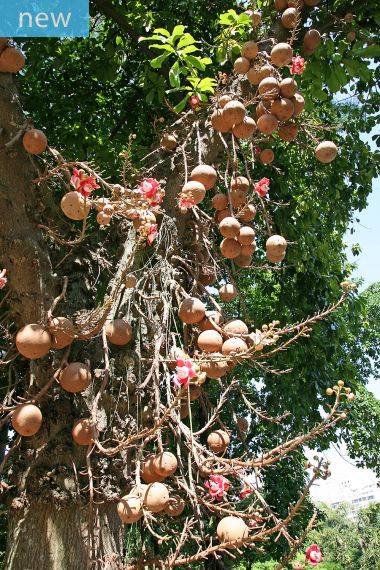
TRZ069 Cannonball Tree ( Couroupita guianensis )
A stunning, large tree with long, spreading branches and blunt-tipped leaves with light green veins, neatly whorled around the branches. The large, red flowers grow on leafless inflorescences directly on the trunk and lower branches. The remarkable fruits are the size, shape and color of a slightly rusty cannonball and a tree loaded with these is quite a sight. Native to tropical lowland forests in Central and South America, Couroupita guianensis is one of three species in this genus and the most well know and widely cultivated in the tropics elsewhere. A great, easy to grow tree for the tropical garden though ideally situated away from walkways and streets because of falling fruits. Zone 10 and higher.
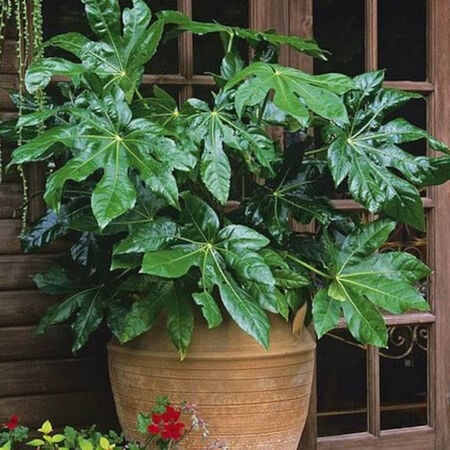
Image:Emőke Dénes, CC BY-SA 4.0, via Wikimedia Commons
JB266 Japanese Arailia ( Fatsia japonica )
A very versatile plant for indoor and outdoor use. Large, exotic, rich green foliage adds an exciting and bold tropical look to landscapes and patios. Great in a shaded entryway or patio, or in a sheltered spot near a water garden or dipping pool. Perfect for outdoor containers or as a houseplant. Ideal for low light, urban settings. Winter flowers are followed by black ornamental berries. Evergreen. One of the most familiar house plants around. Its huge star shaped leaves will decorate any patio or hallway. It also makes a good yard plant if given lots of light. Zones 8A-11 outside.
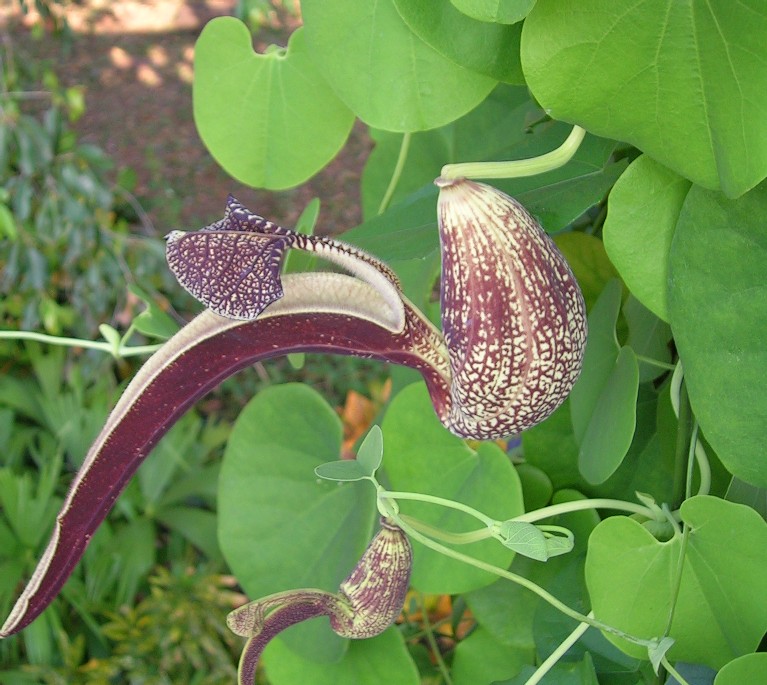
TWT277 Gaping Dutchman's Pipe ( Aristolochia ringens )
An evergreen vine in warm zones, the tops will be killed to the ground in freezing weather but usually return in the spring in zone 8.
It likes to grow in a light and airy place, but not in direct sunlight. The plant can endure short periods of drought and still look fresh. From spring to summer, the vine produces quantities of 4-5 inch long fragrant flowers scattered among the drooping leaves. The flowers trap insect pollinators and facilitate cross pollination. Highly entertaining flowers; a vigorous grower, the outrageous blooms are patterned with a network of burgundy, red, and purple over a creamy-yellow background. The fruit is a capsule, green maturing to brown and opening to release many fertile seeds. Prune back shoots after flowering.
Features: A vine with beautiful dark green heart shaped leaves and paler underneath. These are about 3 inches long by 1-1/2 inch wide and grow closely together to create a dense mass of foliage. These slender woody stems twine gracefully in tight coils around fence wire and other supports lifting itself to heights of 6 to 30 feet. Stems age to woody.
Features: A vine with beautiful dark green heart shaped leaves and paler underneath. These are about 3 inches long by 1-1/2 inch wide and grow closely together to create a dense mass of foliage. These slender woody stems twine gracefully in tight coils around fence wire and other supports lifting itself to heights of 6 to 30 feet. Stems age to woody.
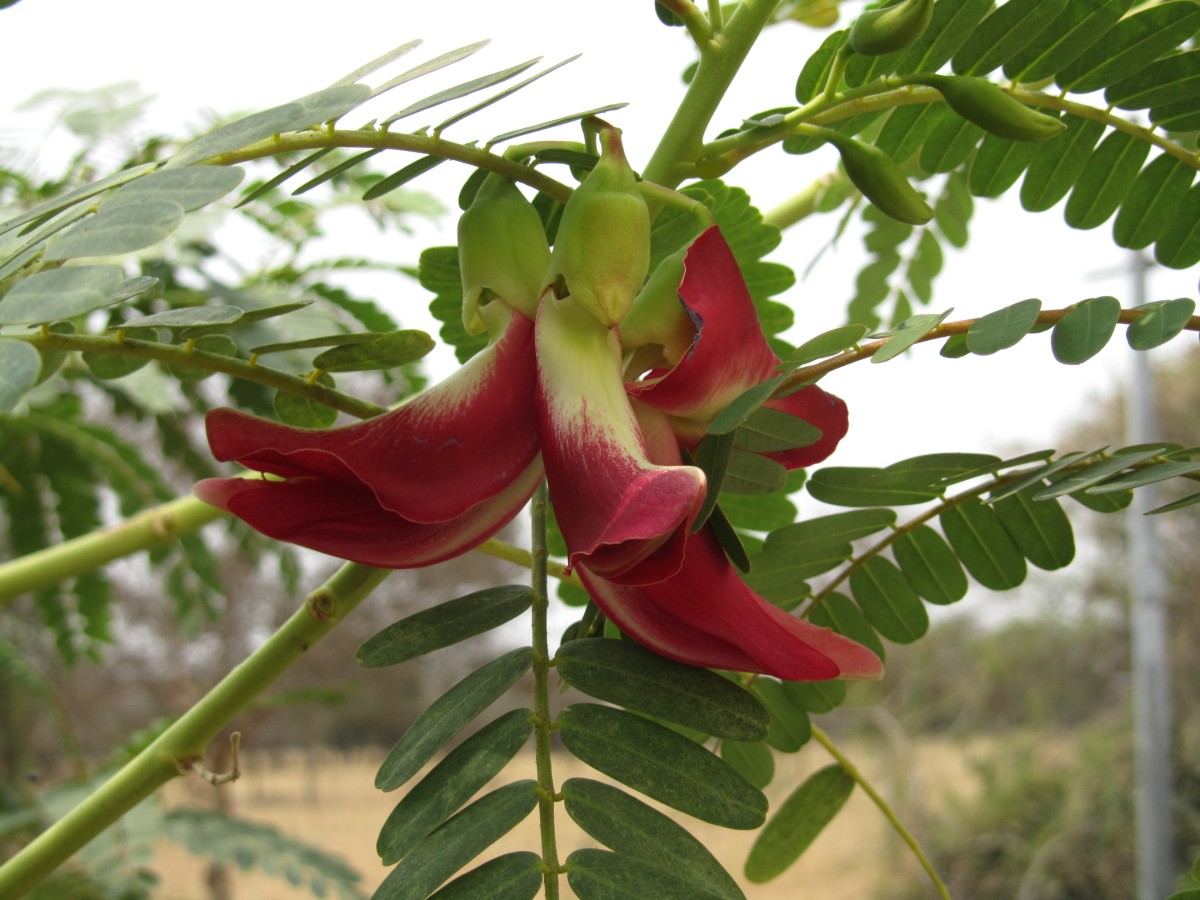
Image: Viky.nandha, CC BY-SA 3.0, via Wikimedia Commons
JB110 Hummingbird Tree ( Sesbania Grandiflora )
Seen from a distance, the Hummingbird Tree's clusters of bright red flowers resemble a group of fluttering hummingbirds hovering around your tree. Hummingbird Trees can produce blooms in varying hues of red, white and pink, and this red-flowering variety will pack a unique and colorful look in your home or yard.
It is also known as the Vegetable Hummingbird Tree as it's leaves, flowers, and fruits can all be consumed. You cam enjoy them raw, or toss them into soups, stews, and stir fry dishes for extra nutritional value. It also has medicinal uses, beloved in Southeast Asia for teas and salves.
This is a somewhat tropical plant best suited for zones 9-11 outside, but it does very well inside in containers, and blooms well in pots and tubs. Will grow 40 feet tall in warm zones, but will limit it's size inside to the size container it is grown in.
It has fern-like fronds in a vibrant green color. Bright red flowers are followed by green fruit pods that grow up to 23 inches long, complementing the tree’s droopy canopy look. This beautiful tree will attract hummingbirds and pollinators, and its timber can even be used for woodworking. As a fully grown tree, it provides excellent shade for seating areas or low-growing plants at its base.
It is also known as the Vegetable Hummingbird Tree as it's leaves, flowers, and fruits can all be consumed. You cam enjoy them raw, or toss them into soups, stews, and stir fry dishes for extra nutritional value. It also has medicinal uses, beloved in Southeast Asia for teas and salves.
This is a somewhat tropical plant best suited for zones 9-11 outside, but it does very well inside in containers, and blooms well in pots and tubs. Will grow 40 feet tall in warm zones, but will limit it's size inside to the size container it is grown in.
It has fern-like fronds in a vibrant green color. Bright red flowers are followed by green fruit pods that grow up to 23 inches long, complementing the tree’s droopy canopy look. This beautiful tree will attract hummingbirds and pollinators, and its timber can even be used for woodworking. As a fully grown tree, it provides excellent shade for seating areas or low-growing plants at its base.
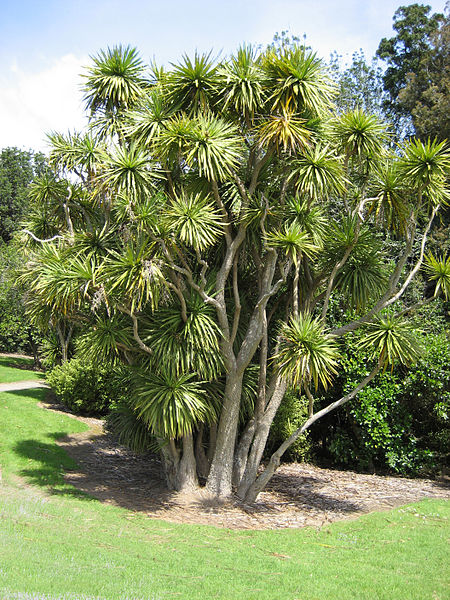
Image:Kahuroa, Public domain, via Wikimedia Commons
JB267 New Zealand Cabbage Tree Palm ( Cordyline australis )
Cabbage Tree is a flowering, evergreen, single or multi-trunked tree in the asparagus family and one of the most recognized plants in its native New Zealand. The plant can reach a height of 30 to 60 feet in its native habitat at maturity. It can also be grown as an ornamental in a container and, in that environment, will slowly develop a cane-like trunk or trunks and reach a height of 15 feet. The small, fragrant flowers of the Cabbage Tree bloom in late spring. The leaves of the tree are sword-like with a 3 foot length and 3 inch width and cluster at the tips of the branches.
Cabbage Tree tolerates a wide range of soils ranging from wet boggy conditions to dry ones. If grown outdoors, it does best in moist, fertile, organically rich, well-drained soils in full sun to part shade. When grown in containers outside on patios in summer, it can be brought in over the winter or grown indoors year-round as a houseplant. If grown in a container, keep soils consistently moist in summer but reduce moisture indoors in winter and site the plant in bright sunny spots in the home or greenhouse. Also note that container-grown plants rarely flower.
Cabbage Tree has a taproot that needs the root space of a large and deep container for best growth. Young plants consisting of a fountain of grass-like leaves with no trunk are often sold as houseplants. Zones 8-11, or inside plant for colder zones.
Cabbage Tree tolerates a wide range of soils ranging from wet boggy conditions to dry ones. If grown outdoors, it does best in moist, fertile, organically rich, well-drained soils in full sun to part shade. When grown in containers outside on patios in summer, it can be brought in over the winter or grown indoors year-round as a houseplant. If grown in a container, keep soils consistently moist in summer but reduce moisture indoors in winter and site the plant in bright sunny spots in the home or greenhouse. Also note that container-grown plants rarely flower.
Cabbage Tree has a taproot that needs the root space of a large and deep container for best growth. Young plants consisting of a fountain of grass-like leaves with no trunk are often sold as houseplants. Zones 8-11, or inside plant for colder zones.
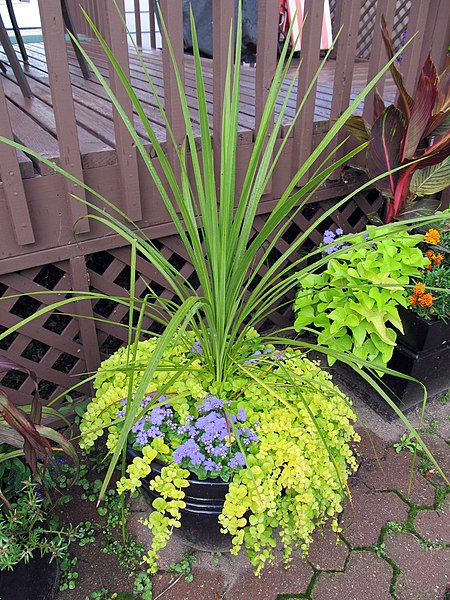
Image: daryl_mitchell from Saskatoon, Saskatchewan, Canada, CC BY-SA 2.0, via Wikimedia Commons
LET694 Spikes ( Cordyline indivisa )
This is a great patio plant and a a wonderful houseplant when grown in containers inside. This is the quickest growing strain of Cordyline indivisa and has smaller, more slender leaves.
A slow-growing evergreen tree, the Cordyline indivisa is commonly referred to as the mountain cabbage tree, blue dracaena, or Toi in its native New Zealand. These easy-to-grow trees were introduced to the United States during the 1800s and now add tropical flair to temperate gardens. A container plant to be enjoyed outdoors on the patio in the summer, as well as kept indoors year-round. Outside, it could grow to 10 feet or so tall, but grown in containers, it will stay much smaller, limited by the size of the container.
Zones 8-12 outside, but almost anywhere when grown in containers inside.
A slow-growing evergreen tree, the Cordyline indivisa is commonly referred to as the mountain cabbage tree, blue dracaena, or Toi in its native New Zealand. These easy-to-grow trees were introduced to the United States during the 1800s and now add tropical flair to temperate gardens. A container plant to be enjoyed outdoors on the patio in the summer, as well as kept indoors year-round. Outside, it could grow to 10 feet or so tall, but grown in containers, it will stay much smaller, limited by the size of the container.
Zones 8-12 outside, but almost anywhere when grown in containers inside.
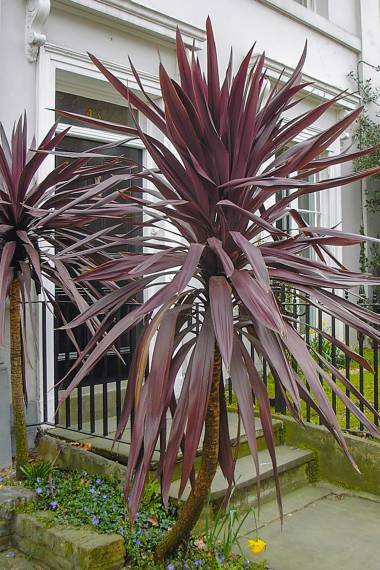
JB220 Bronze Spike ( Cordyline atropurpurea )
Also known as Purple Dragon Tree. This is a great houseplant, or patio tub plant with a unique look. A good container plant when young, and makes an architectural tree when mature.
Sun loving drought tolerant plant for patio, container or outside. Ornamental bark and striking foliage for all year round color and screening. Will stay smaller in container, will grow to about 12 feet outside when mature. This palm-like sub-tropical tree makes a striking focal plant with its fountain of arching bright burgundy and reddish-bronze sword-like leaves. For a more graceful plant, cut back when young to force multiple trunks. Mature plants bear clusters of small, starry, fragrant white flowers in late spring.
Also recognized as Cordyline australis 'Atropurpurea', this is a popular, naturally occurring cultivar which is purple leaved and slightly shorter than the original species.
Great inside or patio plant, or can be grown full time outdoors in zones 9-10.
Sun loving drought tolerant plant for patio, container or outside. Ornamental bark and striking foliage for all year round color and screening. Will stay smaller in container, will grow to about 12 feet outside when mature. This palm-like sub-tropical tree makes a striking focal plant with its fountain of arching bright burgundy and reddish-bronze sword-like leaves. For a more graceful plant, cut back when young to force multiple trunks. Mature plants bear clusters of small, starry, fragrant white flowers in late spring.
Also recognized as Cordyline australis 'Atropurpurea', this is a popular, naturally occurring cultivar which is purple leaved and slightly shorter than the original species.
Great inside or patio plant, or can be grown full time outdoors in zones 9-10.
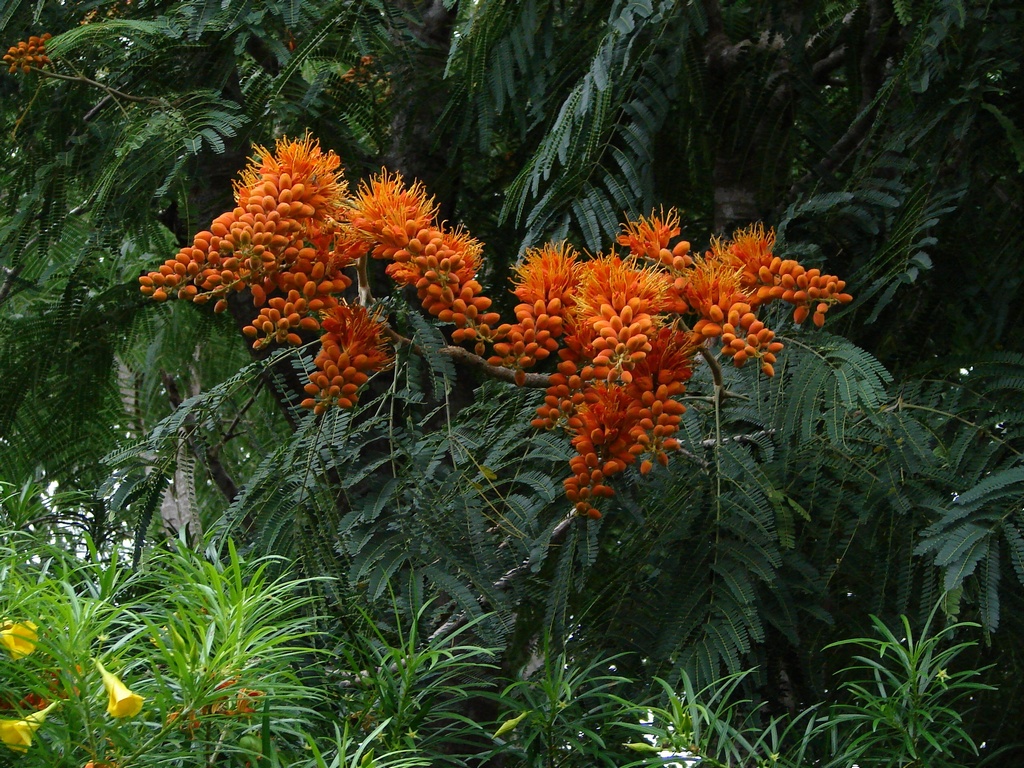
Image: By Tatiana Gerus [CC BY 2.0], via Wikimedia Commons
1A326 Colville Glory Tree ( Colvillea racemosa )
This is a rare, beautiful, flowering tree. Grown outside in zone 10 and higher, but a good tub specimen when young, provides flowers in fall and winter. It grows up right. It has fine leaves like a fern. It is related to the Royal Poinciana. Beautiful cluster of orange flowers!
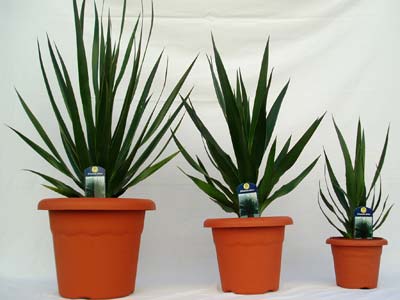
D9918 Large Leaf Dragon Tree ( Dracaena aletriformis )
This relatively fast-growing, beautiful plant requires deep, rich soil and shade. So plant it in fertile, well-drained, compost-enriched soil and keep out of direct sunlight, or the leaves will burn. It requires consistent watering during the growing season and less during winter. It is frost and drought sensitive therefore in colder gardens it will need a very protected position. Due to its tolerance for fairly poor light conditions it makes an exceptional container plant for indoors or for a shady patio providing a bold and attractive focal point.
In Eastern Cape, the root of Dracaena aletriformis is crushed and used as a wash to drive away evil spirits.
In the Canary Islands, the red, resinous, blood-like sap of D. draco has long been used magically, medicinally as well as practically, e.g. it is used as a wash to promote healing and stop bleeding, internally to treat chest pains, internal traumas, post-partum bleeding and menstrual irregularities; it is regarded as a herb of protection, purification and energy; and is also used in mummification, and as a colouring agent in furniture polish, varnish, paint and plaster. It was well known as the source for the varnish used by 18th century Italian violin makers.
In Eastern Cape, the root of Dracaena aletriformis is crushed and used as a wash to drive away evil spirits.
In the Canary Islands, the red, resinous, blood-like sap of D. draco has long been used magically, medicinally as well as practically, e.g. it is used as a wash to promote healing and stop bleeding, internally to treat chest pains, internal traumas, post-partum bleeding and menstrual irregularities; it is regarded as a herb of protection, purification and energy; and is also used in mummification, and as a colouring agent in furniture polish, varnish, paint and plaster. It was well known as the source for the varnish used by 18th century Italian violin makers.
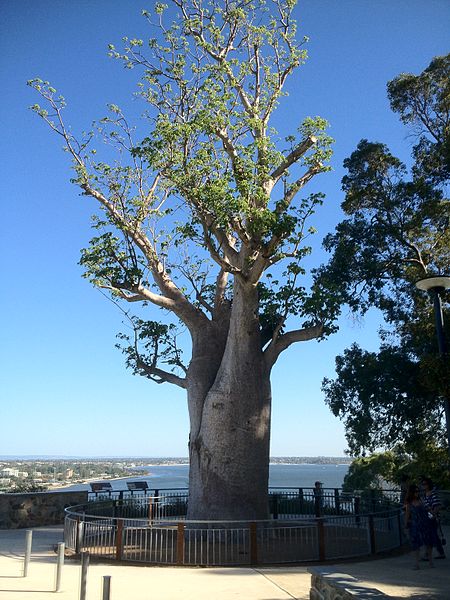
Image:
Image: By Moondyne [CC BY-SA 3.0], from Wikimedia Commons
1A060 Baobab; Lemonade Tree; Monkeybread Tree ( Adonis digitata )
Only the most serious of tree collectors have these unusual trees. The huge trunk of this tree can reach 30' in diameter. Has large 6" hibiscus like flowers and foot long fruits filled with refreshing lemon flavored pulp. The leaves can be eaten like spinach. The trunks store considerable water, as much as 1,000 gallons have been tapped from one. However, if you do not have a half acre to plant one on, they make great bonsai.
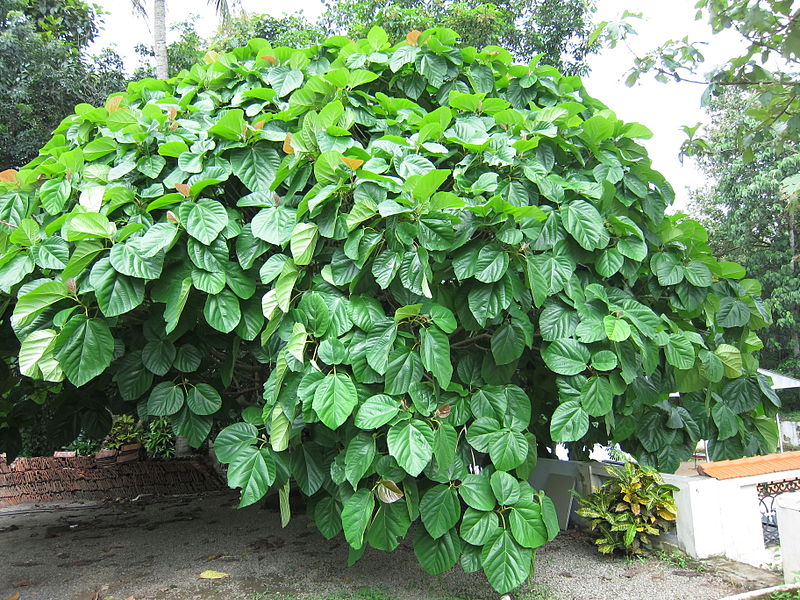
Image: കാക്കര [CC BY-SA 3.0], from Wikimedia Commons
D9916 Elephant Ear Fig ( Ficus auriculata )
A beautiful fig tree with very large oval leaves to 15". The leaves are bright red when they are developing and
exceptionally attractive - the decorative 2 1/2" fruits develop in clusters ( not edible ). This fast growing tree grows to 25' and develop a spreading canopy of 25' but can be kept pruned to a much smaller height.
Makes a sensational indoor specimen. seeds. Cold hardy to 25-30 degrees.
Makes a sensational indoor specimen. seeds. Cold hardy to 25-30 degrees.
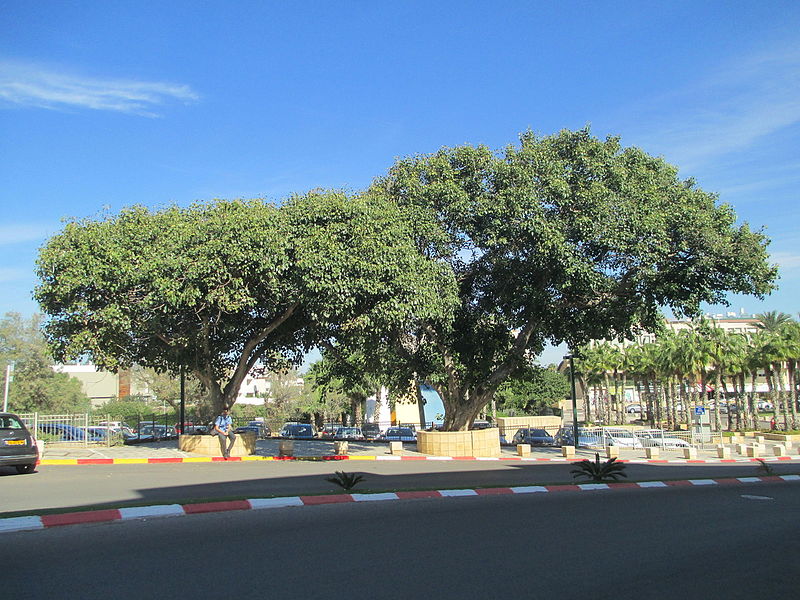
Image: Superikonoskop [CC BY-SA 4.0], via Wikimedia Commons
D4513 Peepful Fig ( Ficus religiosa )
Although it reaches great size outside in warm climates, this makes a wonderful houseplant for many years when grown from seed.
The famous Bodhi tree under which Buddha achieved enlightenment was a Ficus religiosa. In their native habitats, ficus is often seen as a landscape tree with hanging and buttressed roots and a magnificent crown. In the home, ficus is a beautiful specimen plant that can provide many years of lush foliage.
Ficus religiosa, commonly called bo tree, Bodhi tree, peepul and sacred fig, is native to Southeast Asia, southwest China, India and the Himalayan foothills. It is a large broadleaf evergreen tree with wide-spreading branching that grows to 60-100’ tall.
Winter hardy to USDA Zones 10-12 where it grows well in average, moist, well-drained soils in full sun. As a container plant, it is best grown in a soil-based potting mix. Site indoors in bright indirect light or in part shade with protection from afternoon sun. Water regularly during the growing season. Avoid overwatering. Reduce watering from fall to late winter.
Ficus religiosa, commonly called bo tree, Bodhi tree, peepul and sacred fig, is native to Southeast Asia, southwest China, India and the Himalayan foothills. It is a large broadleaf evergreen tree with wide-spreading branching that grows to 60-100’ tall.
Winter hardy to USDA Zones 10-12 where it grows well in average, moist, well-drained soils in full sun. As a container plant, it is best grown in a soil-based potting mix. Site indoors in bright indirect light or in part shade with protection from afternoon sun. Water regularly during the growing season. Avoid overwatering. Reduce watering from fall to late winter.
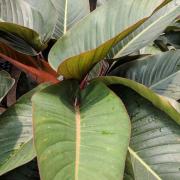
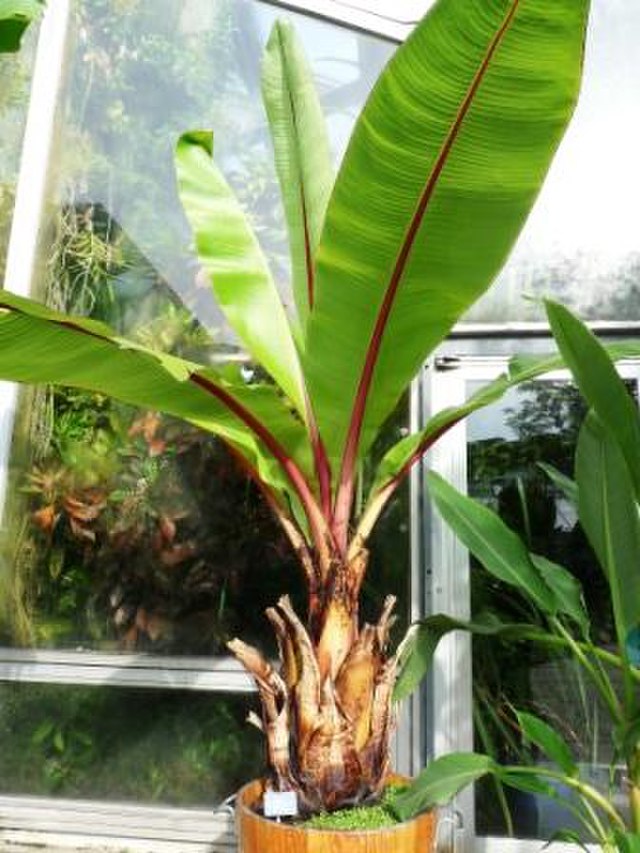
TRZ131 Musa Ensete
This bush type banana is cold hardy into and north of USDA Hardiness Zone 8. Regardless of your climate, you can always enjoy banana type bushes in containers or in greenhouses or as tender perennials. If you crave amazing, tropical, bold-textured foliage and exotic flowers in your garden, you should try growing your own banana bush!
Musa ensete is one of the hardiest types of the Musa family and has very large seeds. This small tree is ideal for conservatories, patios, or as a large potted plant. Only grows about 6 feet tall and is grown for its foliage; unfortunately, no bananas on Musa Ensete. Decorative, huge leaves rivalling any expensive mature house plants. Grows 3 feet in the first four months after seed germination!
Sow anytime of year after soaking the seeds for 24 hours in lukewarm water. Use a peat based seed compost and sow 1/4 inch deep. After sowing, seal the seed container inside a polythene bag in order to keep the compost moist. Germination is slow and erratic and can take 1 - 6 months at 80F. As each seed germinates, transfer it to a 3 in pot of good free draining compost, taking care not to damage the fragile roots. Pot on as required, the larger the container the larger the plant will grow.
Grow Musa ensete bush in warm, well lit conditions. During summer they can be stood outside or planted in the border but should be brought into well lit frost free conditions for the winter when it should be kept moderately dry. Some discoloration of the leaf ends may occur through the winter months but this won't harm the plant.
Zone 8 or higher outside, but often grown as a houseplant or patio plant.
Musa ensete is one of the hardiest types of the Musa family and has very large seeds. This small tree is ideal for conservatories, patios, or as a large potted plant. Only grows about 6 feet tall and is grown for its foliage; unfortunately, no bananas on Musa Ensete. Decorative, huge leaves rivalling any expensive mature house plants. Grows 3 feet in the first four months after seed germination!
Sow anytime of year after soaking the seeds for 24 hours in lukewarm water. Use a peat based seed compost and sow 1/4 inch deep. After sowing, seal the seed container inside a polythene bag in order to keep the compost moist. Germination is slow and erratic and can take 1 - 6 months at 80F. As each seed germinates, transfer it to a 3 in pot of good free draining compost, taking care not to damage the fragile roots. Pot on as required, the larger the container the larger the plant will grow.
Grow Musa ensete bush in warm, well lit conditions. During summer they can be stood outside or planted in the border but should be brought into well lit frost free conditions for the winter when it should be kept moderately dry. Some discoloration of the leaf ends may occur through the winter months but this won't harm the plant.
Zone 8 or higher outside, but often grown as a houseplant or patio plant.
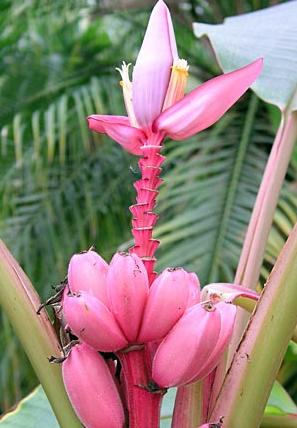
Z2306 Velvet Banana ( Musa velutina )
Good container type of banana with dark green leaf blades to 3
ft. Produces erect spikes of white flowers, followed by softly
hairy, pink fruit. Good for zone 9 and higher outside.
Price per pack: $4.95
Price per pack: $4.95
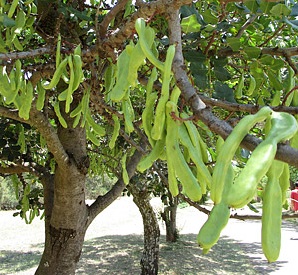
D2249 Carob Tree ( Ceratonia )
Ceratonia siliqua, commonly known as the carob tree, St John's-bread, or locust bean is a species of flowering evergreen shrub or tree in the pea family, Fabaceae.
It is widely cultivated for its edible pods, and as an ornamental tree in gardens. The ripe, dried pod is often ground to carob powder, which is used to replace cocoa powder. Carob bars, an alternative to chocolate bars, are often available in health-food stores.
Carob consumed by humans is the dried (and sometimes roasted) pod. The pod consists of two main parts: the pulp accounts for 90% and the seeds for 10% of the pod weight.
Carob is mildly sweet and is used in powdered, chip or syrup form as an ingredient in cakes and cookies, and as a substitute for chocolate. Carob bars are widely available in health food stores. A traditional sweet, eaten during Lent and Good Friday, is also made from carob pods in Malta. Dried carob fruit is traditionally eaten on the Jewish holiday of Tu Bishvat.
While chocolate contains levels of theobromine which are toxic to some mammals, carob contains significantly less caffeine and theobromine, and is therefore used to make chocolate-flavored treats for dogs.
Carob pod meal is used as an energy-rich feed for livestock, particularly for ruminants, though its high tannin content may limit its use. Carob pods were mainly used as animal fodder in the Maltese Islands, apart from times of famine or war when they formed part of the diet of many Maltese. In the Iberian Peninsula, carob pods were used to feed donkeys.
The carob tree is native to the Mediterranean region, including Southern Europe, Northern Africa, the larger Mediterranean islands; to the Levant and Middle-East of Western Asia into Iran; and to the Canary Islands and Macaronesia.
Carob trees may be grown in USDA zones 9-11.
It is widely cultivated for its edible pods, and as an ornamental tree in gardens. The ripe, dried pod is often ground to carob powder, which is used to replace cocoa powder. Carob bars, an alternative to chocolate bars, are often available in health-food stores.
Carob consumed by humans is the dried (and sometimes roasted) pod. The pod consists of two main parts: the pulp accounts for 90% and the seeds for 10% of the pod weight.
Carob is mildly sweet and is used in powdered, chip or syrup form as an ingredient in cakes and cookies, and as a substitute for chocolate. Carob bars are widely available in health food stores. A traditional sweet, eaten during Lent and Good Friday, is also made from carob pods in Malta. Dried carob fruit is traditionally eaten on the Jewish holiday of Tu Bishvat.
While chocolate contains levels of theobromine which are toxic to some mammals, carob contains significantly less caffeine and theobromine, and is therefore used to make chocolate-flavored treats for dogs.
Carob pod meal is used as an energy-rich feed for livestock, particularly for ruminants, though its high tannin content may limit its use. Carob pods were mainly used as animal fodder in the Maltese Islands, apart from times of famine or war when they formed part of the diet of many Maltese. In the Iberian Peninsula, carob pods were used to feed donkeys.
The carob tree is native to the Mediterranean region, including Southern Europe, Northern Africa, the larger Mediterranean islands; to the Levant and Middle-East of Western Asia into Iran; and to the Canary Islands and Macaronesia.
Carob trees may be grown in USDA zones 9-11.
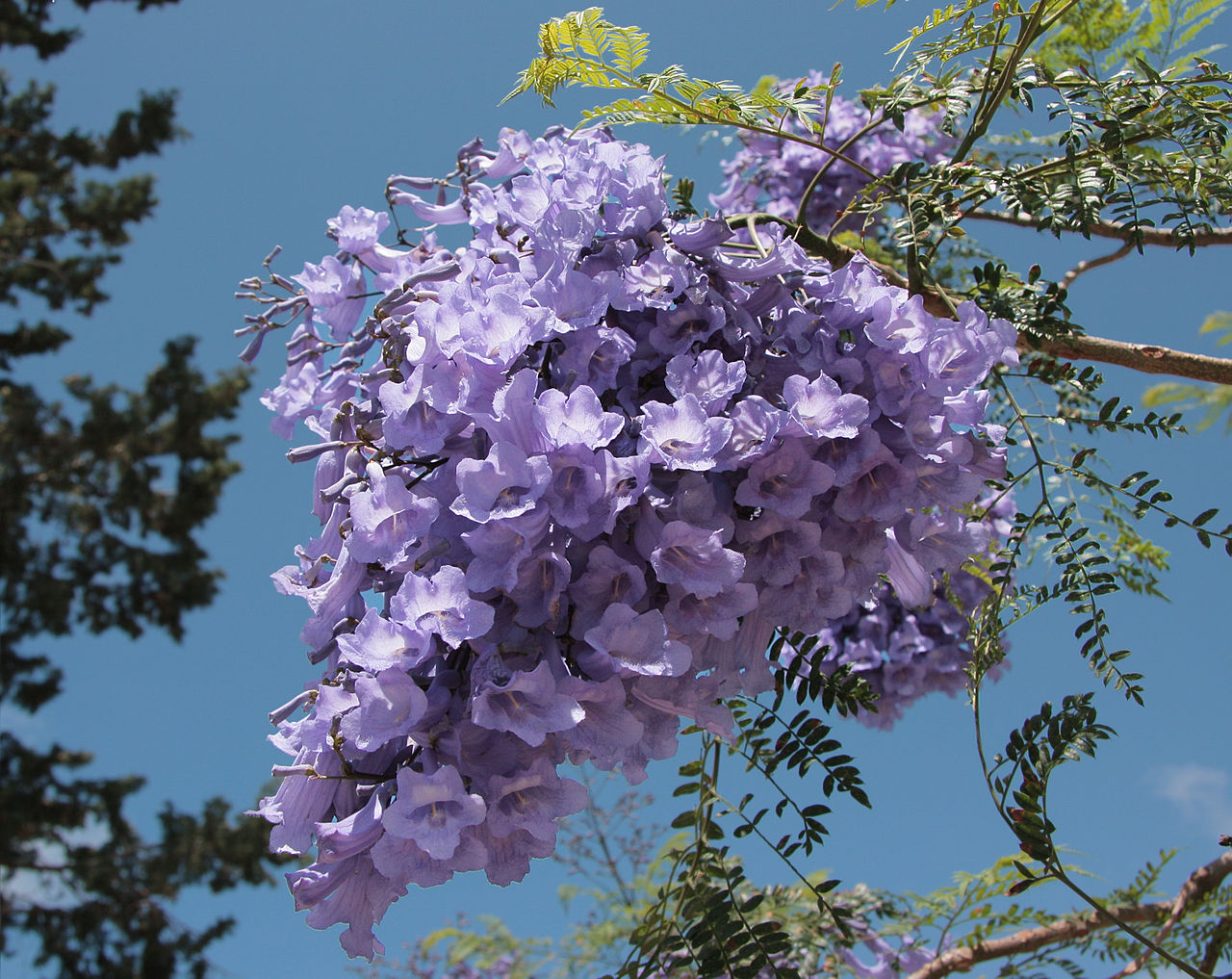
Image: By Anna Anichkova [CC BY-SA 3.0], from Wikimedia Commons
D2905 Jacaranda Tree ( Jacaranda mimosifolia )
Jacaranda mimosifolia is a sub-tropical tree native to south-central South America that has been widely planted elsewhere because of its attractive and long-lasting violet-colored flowers. It is also known as the jacaranda, blue jacaranda, black poui, Nupur or fern tree.
The tree grows to a height of up to 60 or so feet tall in it's native climate, but also makes a good tub plant when young for cooler climates. Its bark is thin and grey-brown, smooth when the tree is young but eventually becoming finely scaly. The twigs are slender and slightly zigzag; they are a light reddish-brown. The flowers are up to 2 inches long, and are grouped in 12 inch panicles. They appear in spring and early summer, and last for up to two months. They are followed by woody seed pods, about 2 inches in diameter, which contain numerous flat, winged seeds. The blue jacaranda is cultivated for the sake of its large compound leaves, as well as it's flowers.
The blue jacaranda has been cultivated in almost every part of the world where there is no risk of frost; established trees, however, tolerate brief spells of temperatures down to around 19 °F. In the US, in areas where winter temperatures can dip to 10 °F for several-hour periods, the mature tree survives with little or no visible damage. Even when young trees are damaged by a hard frost and suffer dieback, they will often rebound from the roots and grow in a shrub-like, multi-stemmed form.
The tree grows to a height of up to 60 or so feet tall in it's native climate, but also makes a good tub plant when young for cooler climates. Its bark is thin and grey-brown, smooth when the tree is young but eventually becoming finely scaly. The twigs are slender and slightly zigzag; they are a light reddish-brown. The flowers are up to 2 inches long, and are grouped in 12 inch panicles. They appear in spring and early summer, and last for up to two months. They are followed by woody seed pods, about 2 inches in diameter, which contain numerous flat, winged seeds. The blue jacaranda is cultivated for the sake of its large compound leaves, as well as it's flowers.
The blue jacaranda has been cultivated in almost every part of the world where there is no risk of frost; established trees, however, tolerate brief spells of temperatures down to around 19 °F. In the US, in areas where winter temperatures can dip to 10 °F for several-hour periods, the mature tree survives with little or no visible damage. Even when young trees are damaged by a hard frost and suffer dieback, they will often rebound from the roots and grow in a shrub-like, multi-stemmed form.
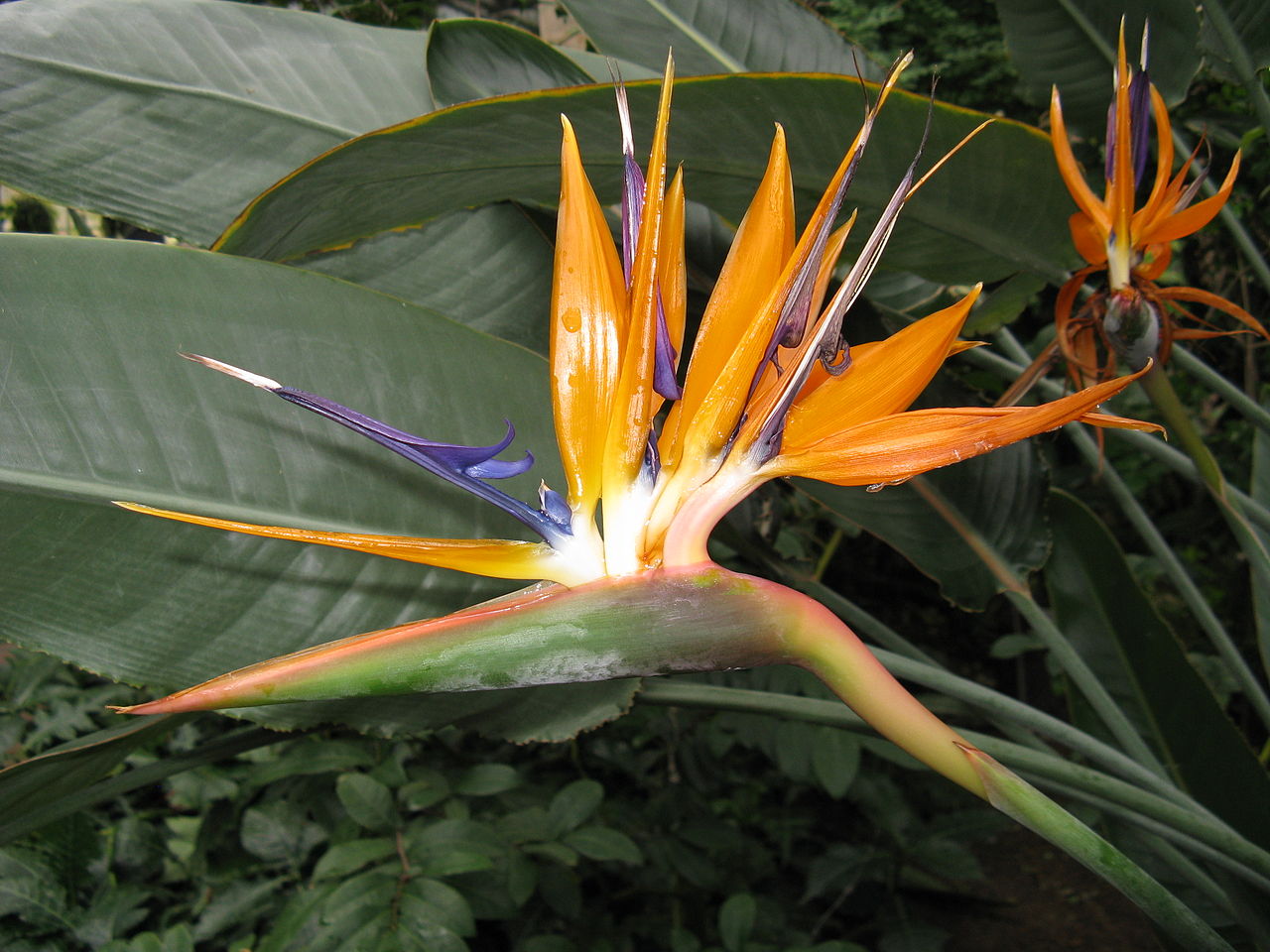
D1109 Bird of Paradise ( Strelitzia reginae )
One of the most attractive of all tropical plants.
The Bird of Paradise is delightfully easy to care for and enjoys warm, balmy days year round. The stunning flowers of this unique plant make it popular in gardens around the globe.
Flowering occurs multiple times a year if the plant is well taken care of. It is a long lived plant, and takes up to three years to begin producing flowers. Once it begins flowering, however, this plant will provide you with years of delight.
Once flowering begins in early spring, each plant will produce up to six flowers in succession, with each flower being long-lived. Blooming can be almost continuous from early spring into early fall, provided the plant is cared for. This plant requires little encouragement to bloom, happy with enough light and water for its needs.
It comes from S Africa. The flowers take shape of a most peculiar form, resembling birds in flight. Grows to a height of about 3 feet in containers, but can reach 6 feet outside.
They can tolerate temperatures as low as 55 degrees, but prefer to remain in the 70-90 degree range.
The Bird of Paradise is delightfully easy to care for and enjoys warm, balmy days year round. The stunning flowers of this unique plant make it popular in gardens around the globe.
Flowering occurs multiple times a year if the plant is well taken care of. It is a long lived plant, and takes up to three years to begin producing flowers. Once it begins flowering, however, this plant will provide you with years of delight.
Once flowering begins in early spring, each plant will produce up to six flowers in succession, with each flower being long-lived. Blooming can be almost continuous from early spring into early fall, provided the plant is cared for. This plant requires little encouragement to bloom, happy with enough light and water for its needs.
It comes from S Africa. The flowers take shape of a most peculiar form, resembling birds in flight. Grows to a height of about 3 feet in containers, but can reach 6 feet outside.
They can tolerate temperatures as low as 55 degrees, but prefer to remain in the 70-90 degree range.
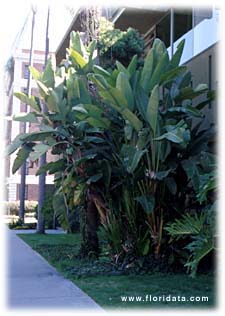
JB268 Giant White Bird of Paradise ( Strelitzia
nicolai )
Bird of paradise is a stunning tropical plant commonly grown as a houseplant throughout the country and a landscape plant in zones 9 and up. These are among the most popular houseplant and patio plants in use today.
This famous giant tropical plant is known for reaching 12 feet or more outdoors in height and bearing loads of brilliant white flowers.
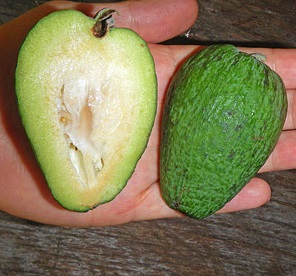
D2925 Pineapple Guava ( Feijoa )
A beautiful evergreen shrub that is easy to grow. Has dark
green leaves with silvery underneath. The flowers are very
attractive. The fruit is yellow green and has a pleasant pear
like taste.
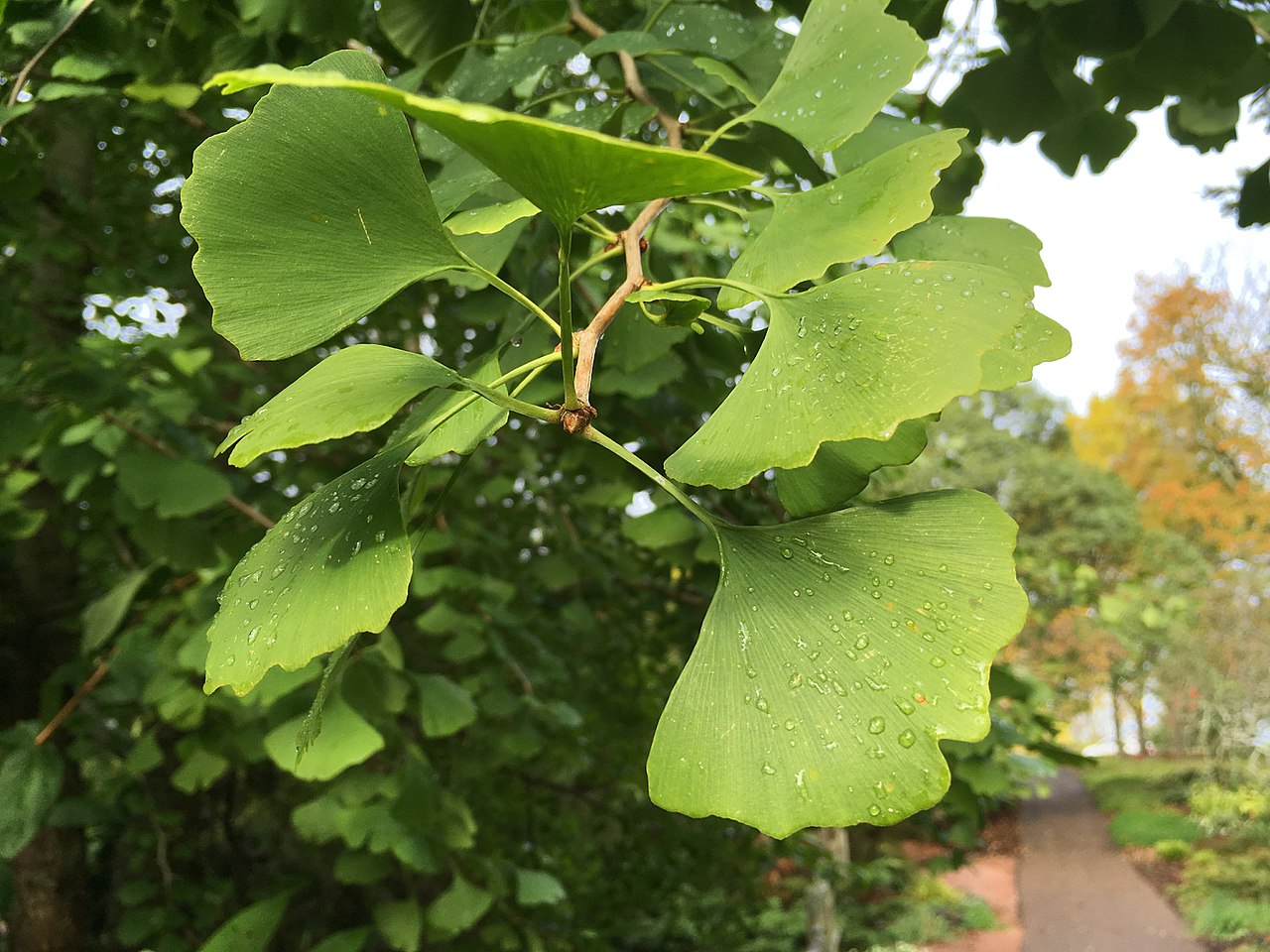
Image: By YSmomilomii [CC BY-SA 4.0], from Wikimedia Commons
D2977 Gingko Biloba
A most unique tree with colorful, beautiful foliage. A great ornamental tree famous for its interesting shape and vibrant foliage, it stands out with a tall, rounded form and delicately-crafted leaves.
Unique, fan-shaped leaves turn a stunning yellow color in the fall. It can tolerate many urban conditions including heat, air pollution, salt, and confined spaces. And it establishes easily. And it thrives just about anywhere in the United States. It's especially perfect for urban areas since it won't be bothered by smog and other pollution.
The Ginkgo tree is a living fossil, with the earliest leaf fossils dating from 270 million years ago. It was rediscovered in 1691 in China and was brought to this country in the late 1700s. The seeds and leaves have been (and are still today) used in medicine throughout the world.
An interesting fact about the ginkgo,there are only five living groups of seed plants, and ginkgo is one of them. And ginkgo is the only one that consists of just one species.
Excellent selection for a variety of uses, including lawn tree, street tree or shade tree. Also effective in city parks or near commercial buildings. A mature tree can grow to 80 feet tall with a 30-40 feet wide canopy. Its nuts are regarded as a delicacy in the Orient. It is the source of the famous herbal supplement. A favorite bonsai specimen. Well suited for zones 3-8.
For more info on the Ginko, please visit the Gingko Page
Unique, fan-shaped leaves turn a stunning yellow color in the fall. It can tolerate many urban conditions including heat, air pollution, salt, and confined spaces. And it establishes easily. And it thrives just about anywhere in the United States. It's especially perfect for urban areas since it won't be bothered by smog and other pollution.
The Ginkgo tree is a living fossil, with the earliest leaf fossils dating from 270 million years ago. It was rediscovered in 1691 in China and was brought to this country in the late 1700s. The seeds and leaves have been (and are still today) used in medicine throughout the world.
An interesting fact about the ginkgo,there are only five living groups of seed plants, and ginkgo is one of them. And ginkgo is the only one that consists of just one species.
Excellent selection for a variety of uses, including lawn tree, street tree or shade tree. Also effective in city parks or near commercial buildings. A mature tree can grow to 80 feet tall with a 30-40 feet wide canopy. Its nuts are regarded as a delicacy in the Orient. It is the source of the famous herbal supplement. A favorite bonsai specimen. Well suited for zones 3-8.
For more info on the Ginko, please visit the Gingko Page


